I think you had better sit down for this one. Gather your smelling salts or a good stiff Death in the Afternoon. For myself, I’ve been gorging on Napoleon torte from the Lithuanian Bakery ever since I’ve heard the news. Steady. It is time we talk about the future of 6300 Dodge Street.
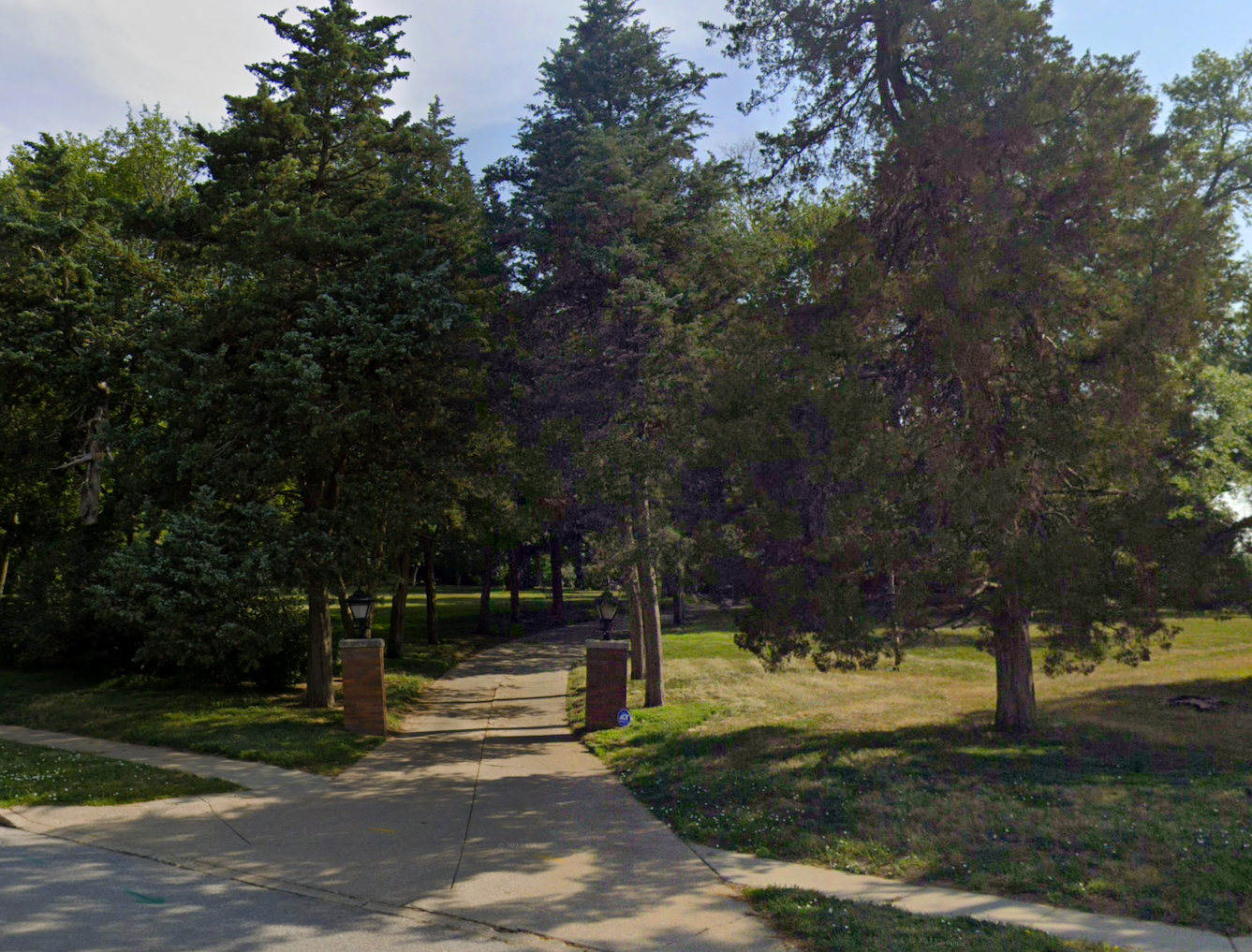
The delicious entry gate of 6300 Dodge is one of the most exciting, understated views in all of Omaha. The twin brick columns stand duty at an angle from the divine Fairacres Road (64th Street) off of Dodge Street. This iconic 6300 Dodge home is directly north of UNO.
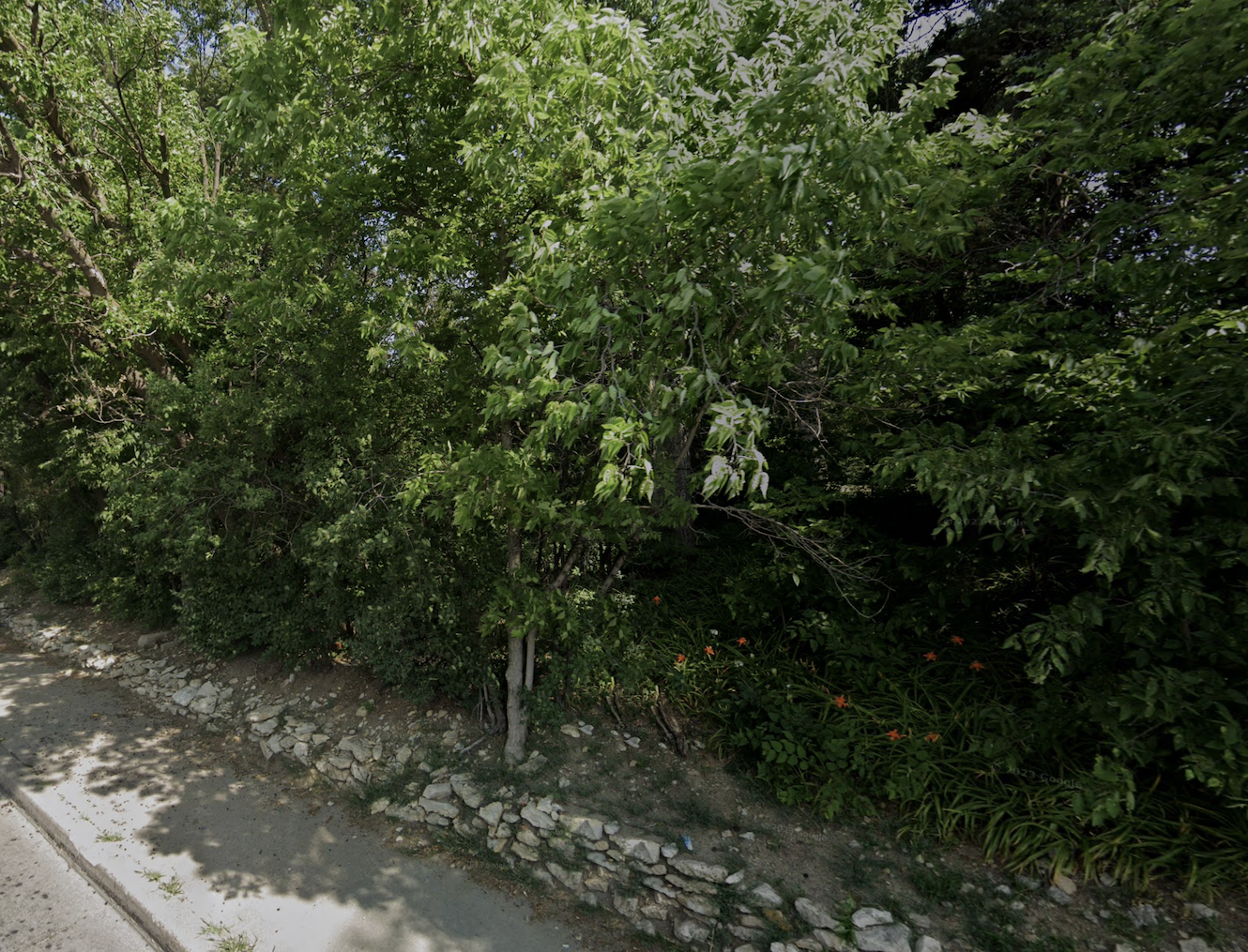
Spring and summer at 6300 Dodge means a fabulous view of clandestine foliage with only hints of the mansion behind.
Today’s investigation will be a longform case, heavy on photos. First the new development portion and then, a bit of history. If you want to read the history first and circle back to us, look off into the distance for the heading: In the Clearing.
Rumored Plans
An Informant called me a few weeks back. The Informant had heard development rumors of 6300 Dodge corroborated by further evidence. The Informant had become privy to developers sniffing around and planning to raze 6300 Dodge Street. Their plat plan, to follow, suggested an intention of building ten or eleven townhomes on the 3.72 Acres lot. To my knowledge, no firm offer has been made and the 6300 Dodge home remains in the current owners’ name. I have found no whiff of suggestion on the City Planning Site.
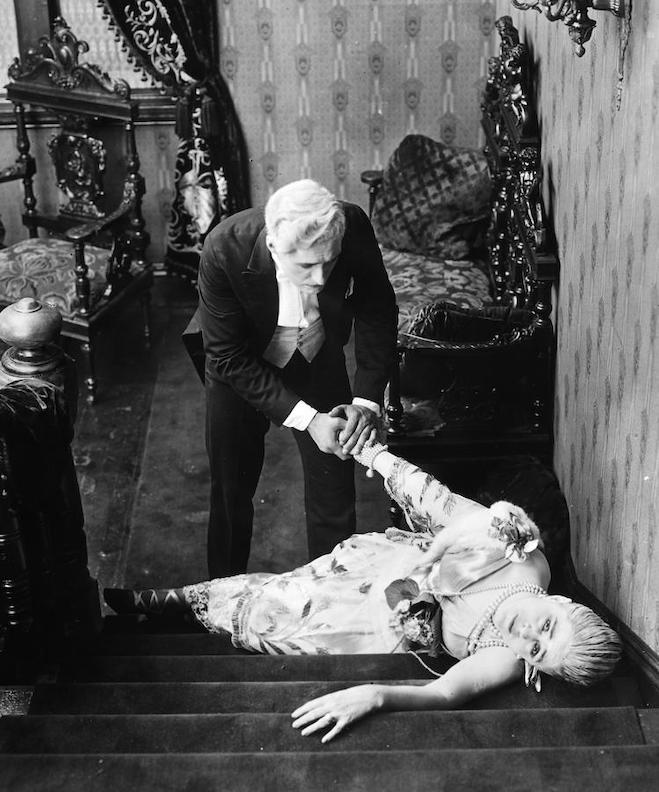
We must find courage to go on.
Arguably 6300 Dodge is one of The Most Known, visible, and daydream-making estates in all of Omaha. Directly across from UNO, 6300 Dodge was introduced to me long ago as Dr. Quinn’s property. Local talk of the greenhouse! The ballroom! The solarium! The chapel! We could gab all day about the size of the home and its prominence in our town, and we will later, but my lasting impression has always been of the gardens, the forever grounds and my desire to look out from this glory of the trees at others passing by. I received a great sense of peace and contentment in seeing Dr. Quinn work his own land, preparing and planting and pecking about. It is a rarity these days to find the master of the manor is also the gardener. I obsessed about his lawn bags spread throughout the massive gardens, proof of how he toiled away, no doubt, in pure bliss. One bag remains in the front shrubs, very nearly disintegrated after all these years. I pray it is allowed to fully subsume where Dr. Quinn placed it. The soil on this estate is dark, rich and dare I say, celestial.
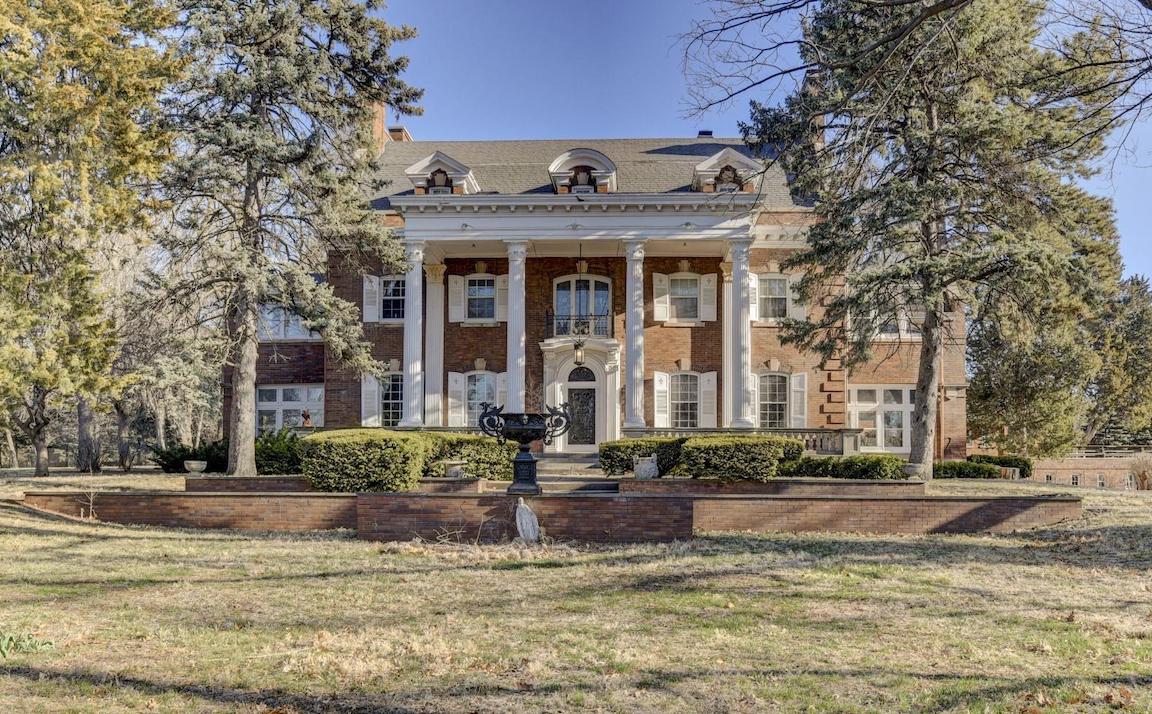
6300 Dodge as she looks today. Photo by Better Homes and Gardens Real Estate.
Nearing a year on the market with the asking price having dropped dramatically from $5.25 million to $3.5 million, Richard Begley, the real estate agent seemingly added the “Spectacular Estate Lot” tag to the property listing recently. On their behalf, the Quinn family and Mr. Begley have worked toward and dreamed of a single family moving into the stately home. (Begley’s real estate listing is shared all over the nation on historic home sites.) This shift in marketing seems to suggest the family is now reluctantly open to a tear-down with development on the lot. The Quinns may believe that after all this, it is time to look at what may be their only perceived option. Or it could have always been a Regrettable Plan B.
Begley’s estate listing for 6300 Dodge Street: https://www.bhgre.com/ne/omaha/6300-dodge-st/lid-P00800000GFDNa16ORcAGVb50yrSW5cvYdrTCKks
While we’re at it, here is his phone number: (402) 216-4109

For myself I had not detected the change to the marketing but feared 6300 Dodge would torn down for a long time. It is exactly what developers are looking for. An A+ location AND it is weakened because of the Fairacres Condominiums, directly to the west. 6300 Dodge is vulnerable as the argument could easily be made to change zoning, as was done when the once great Brandeis mansion site was reconfigured for the condos. On that note, if the Fairacres neighborhood allows this development to pass, the future of the neighborhood becomes that much more weakened.
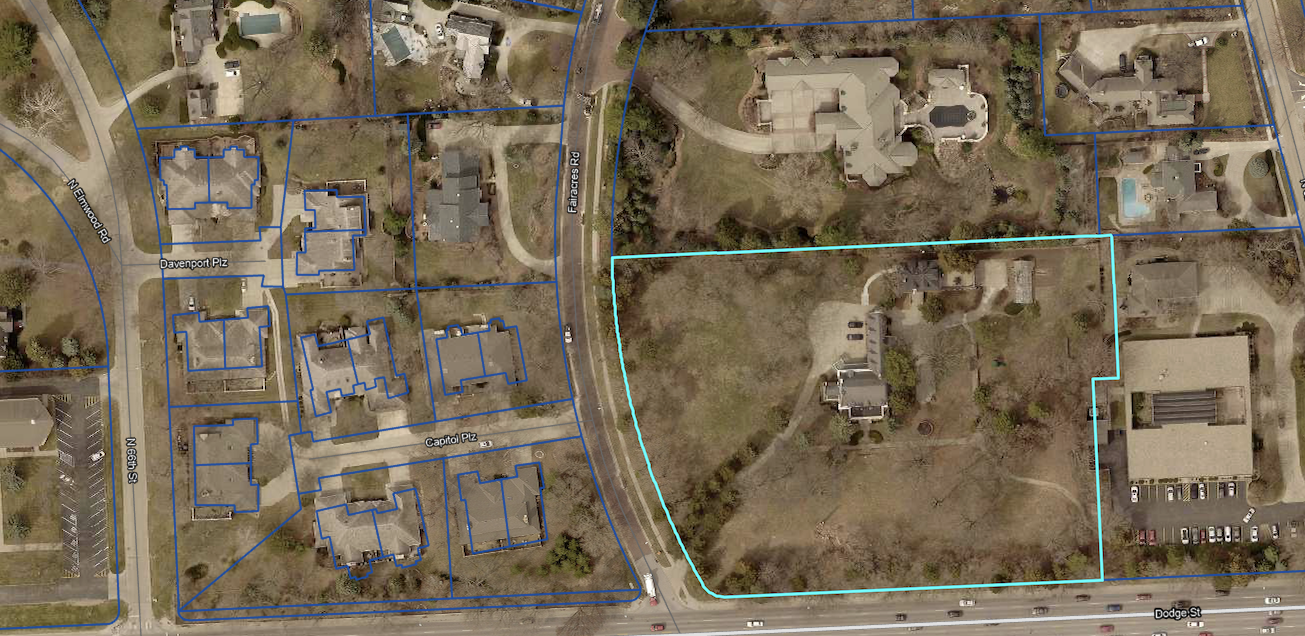
East west Dodge runs the bottom of the photo. 6300 Dodge outlined in turquoise. The Fairacres condos are outlined in navy to the west of 6300 Dodge. They are built on Capitol Plaza and Davenport Plaza, short drives off of Fairacres Road and 66th Street.
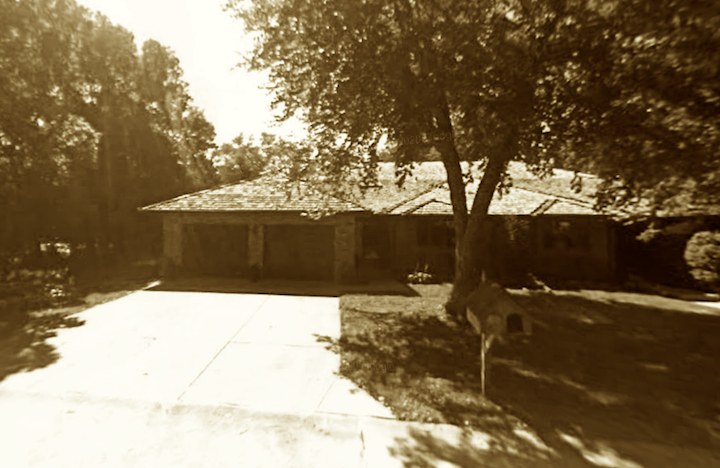
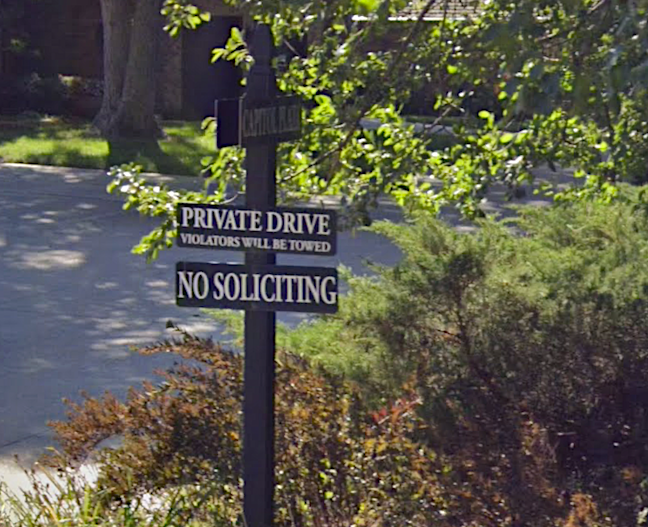
The surreptitious condos on Capitol Plaza….stay away, folks.
TD2 is developing the plat plan for 6300 Dodge Street revealed today. Apparently there is “another developer” inquiring with Fairacres neighbors and asking if they would have a problem with a change from R1 zoning. Knocking on neighbors’ doors in order to determine if the neighborhood would protest a change from the R1 zoning is of serious concern in this case, as understandably, no one is interested in fighting the deep pockets in that neighborhood. The Quinn estate as well as the rest of glorious Fairacres is zoned first residential, calling for single-family homes on large lots. Advancing on and strong arming a community is not as difficult in other neighborhoods, as we have witnessed in our investigations.
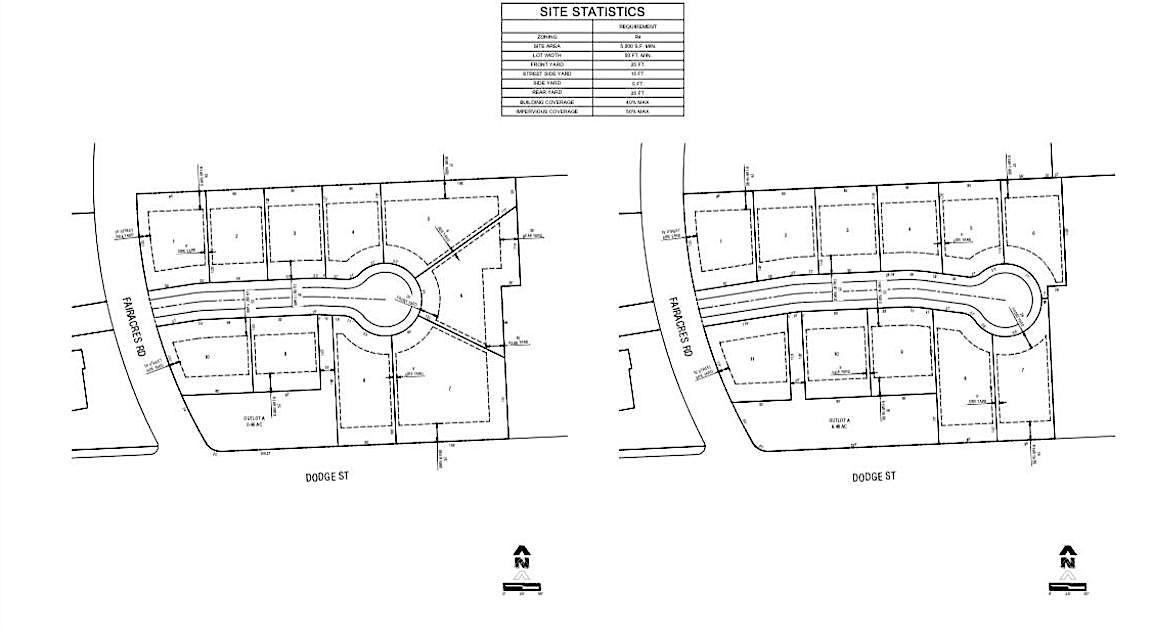
The site plat on the left offers ten lots and the version on the right shows eleven lots in differing configurations.
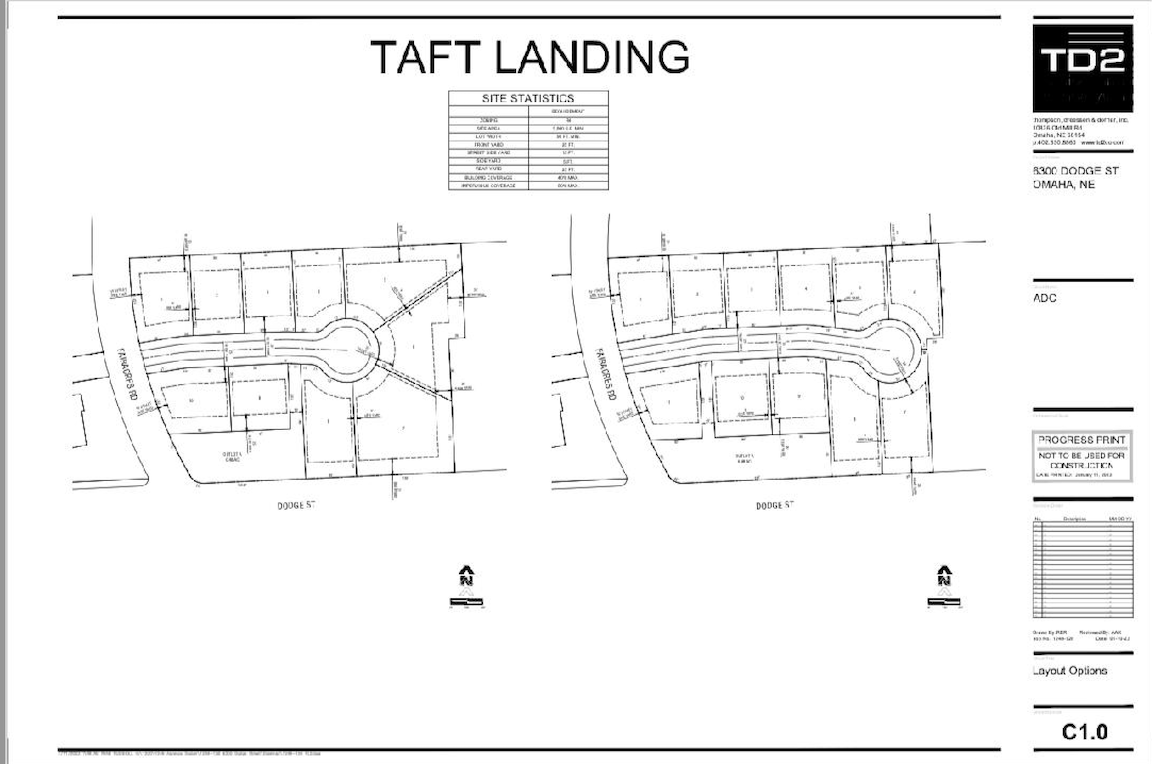
Later evidence showed Knott’s Landing, I mean, Taft Landing as the project name. One of many fears is that investors typically do not share the concerns of our My Omaha Obsession sleuths, regarding tasteful, lasting architecture. My informant’s concern is the aesthetics will be compromised in favor of a quick profit. Purportedly the plans look like West Omaha new builds. No character or definitive style. They’re multi-gabled and multi-sized window affairs. TD2 drawing. For more on this developer, check out TD2.
Ever since I saw Dr. James Quinn’s obituary in October of 2022, I have felt a bit faint in passing the estate. Not only was this the sudden death of a well-known, well-loved local doctor, I knew the family very possibly would have to let go of their house. Back in August of 2018, Dr. and Mrs. Quinn had petitioned the Assessors board to lower their property valuation appraisal, which had shockingly been raised from $1.5 million to $2.6 million in one year. Sean Mullen, attorney for the Quinns said the increase was too much. “It would result in an increased tax burden of more than $20,000 for the elderly owner who’s trying to do everything right.” He also pointed out that the home had been built in 1907 and needed renovations. With a home of this scale, there must be years of deferred maintenance. For these reasons, I tensed for all of the Grand Home Obsessed Omaha but selfishly for myself, to think of the doctor being gone and the greater potential for 6300 Dodge following suit.
I honestly do not know that 6300 Dodge can survive as a single-family residence in these times and in this particular city. As with so many others, I envision an Omaha where 6300 Dodge can find just the right human fit. I would hope that if razed and a new project materializes, that it can be honorable, beautiful and lasting—not the all too common fly by night design. We will watch and wait.

A favorite photo I took back on January 18, 2018.
Yes, I’d been working this case for many years. I am quite over the moon about the 6300 Dodge mansion and as you now know, obsessed with the grounds and Dr. Quinn’s gardening life. Because the World-Herald out-scooped and dashed my dreams of my big investigation, I figured I would wait a few years to share my 6300 Dodge obsession. Time and heart seem pressing now.
In the Clearing
6300 Dodge, Lot 54 of the Fairacres subdivision, is now regarded as the tenth largest houses in Omaha. (I know this because of research for an ongoing investigation coming out on the ten largest homes.) But she wasn’t always one of the largest. In fact she began life as an average, AMAZING house. Fairacres subdivision initiated in 1862 becoming part of the J. N. H. Patrick family holdings; the Patricks held ownership until 1905, when it went to the Dundee Real Estate Co., co-owned by C. C. and J. E. George. Fairacres was said to have been formally plotted in 1907, although I found the Georges selling lots before that. 6300 Dodge is sometimes reported to have been “constructed for Julia Gibson in 1905. Wife of a cattle baron and one of the founders of Packers National Bank.”
Mr. Edgar Gibson was a ranchman but I did not find him to be a founder of Packers National Bank. Edgar M. Gibson was born at Fairfield, Maine in 1847. Early on he worked in the dressed beef business. In 1868, Mr. Gibson married Julia Ann Lawrence. The couple then moved to Nebraska where Gibson got into the livestock and ranch business. In 1891 the news dispatches named a new national bank of South Omaha that was to succeed the Nebraska Saving and Exchange Bank– Packers National was introduced. E. M. Gibson might have entered into the business later, but was not a founding member. Additionally the 6300 Dodge Street house was not constructed in 1905.
Wife Julia A. Gibson began buying properties in Omaha in 1900. And she held quite a few lots in her name. Around this time Julia Gibson hired Architect Henninger to build her 1728 South 32nd Avenue residence. She continued deed gathering until I discovered the Gibson family link to Fairacres in 1907.
Mr. Henninger, please
In March of 1907 the Omaha Daily Bee announced “three modern and expensive country homes are being planned from erection this spring about one mile west of Dundee on the Dodge street road.” Our 6300 Dodge was one of these. I was delighted to find the architect listed—none other than Omaha famous, F. A. Henninger. More specifically about this 6300 home: “Sketches are also being prepared by Mr. Henninger for a brick country house to cost about $15,000 for E. M. Gibson, a wealthy ranchman, which will be built in the immediate neighborhood will be that of C. S. Hayward of the Hayward Brothers Shoe company. Architect Henninger is drawing the preliminary sketches for Mr. Hayward’s home, which will be built on the lot adjoining that of E. M. Gibson on the south and which will cost about $18,000. The main building will be constructed of field stone, which will be shipped from a celebrated New Jersey quarry. L. O. Perley, an attorney and son-in-law of E. M. Gibson, will also build a brick and cement residence on the lot adjoining that of Mr. Gibson on the west, plans for which are being prepared by Architect Henninger.” The entire “colony of homes” would be ready for occupancy before fall of 1907.
Of note for those who don’t like to get stuck in the muddlement, the Gibsons’ daughter (also named Julia) and son in law (Lyman) built a home at the same time, directly to the north of 6300 Dodge. Both homes were designed by one of our obsessions, Frederick A. Henninger, although, oddly, not listed with the Nebraska State Historical Society architecture site. Mrs. Julia Gibson’s previous 32nd Avenue home is logged however. Oversight, no doubt.
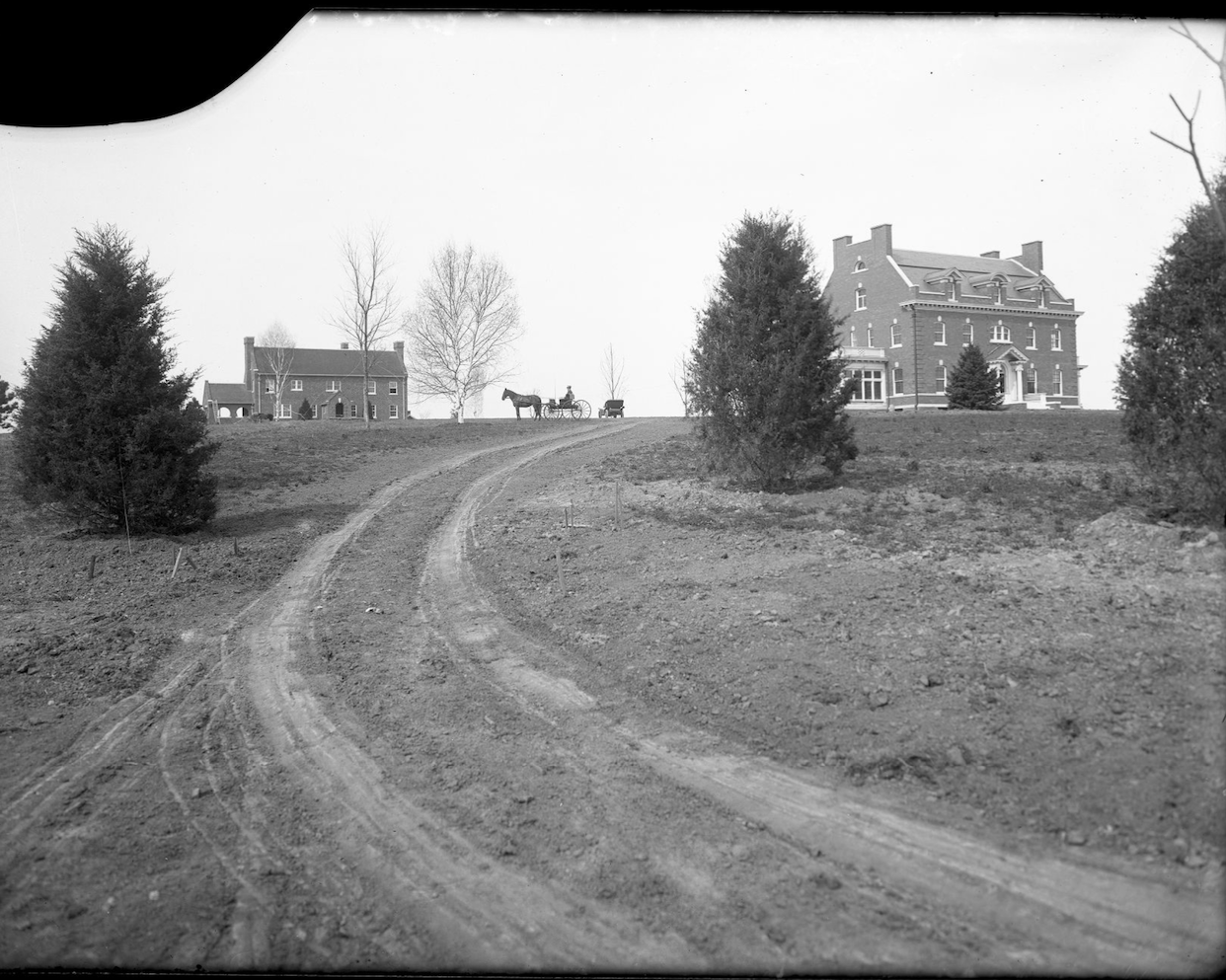
Although this great photograph was taken many years later in 1914, it illustrates both of the Perley and Gibson family homes proximity to one another. It also gives an excellent view of how early 6300 Dodge Street looked before its hoighty renovation. 1914. Photographers Bostwick and Frohardt. Collection of the Durham Museum. Camera faces north east.
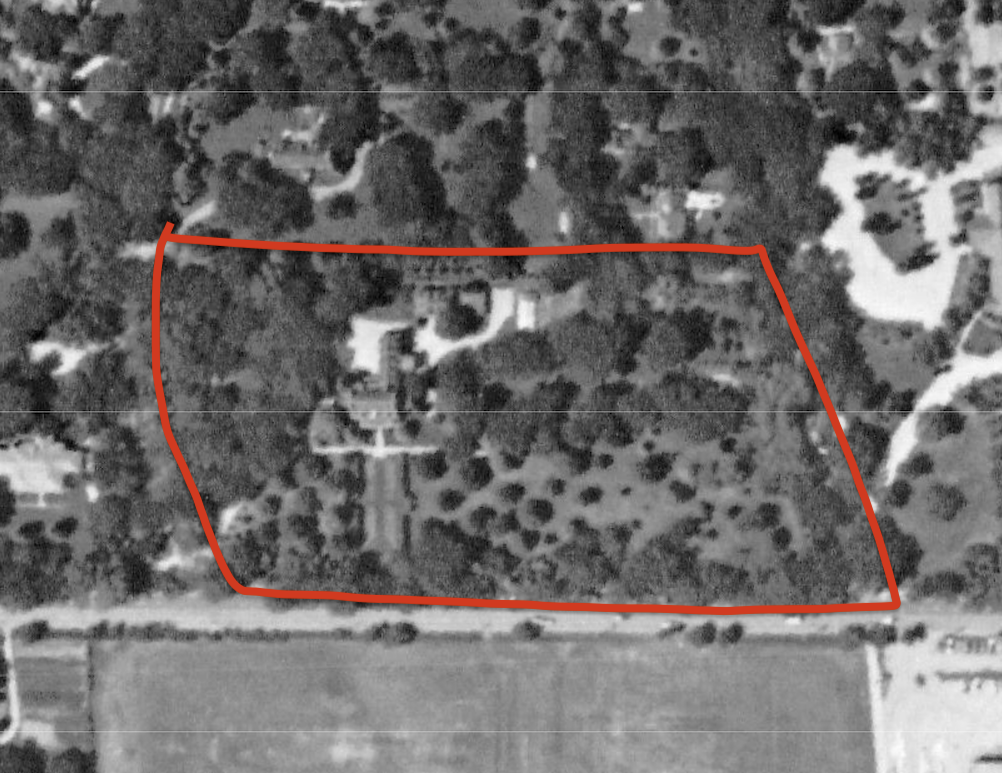
The early Gibson residence was situated on seven acres of land spanning what is now 62nd Street to 63rd Street. My rough red outline denotes the original property line. Aerial image from 1955 borrowed from the DOGIS site. Bear in mind the property had filled in with significant tree growth by 1955.
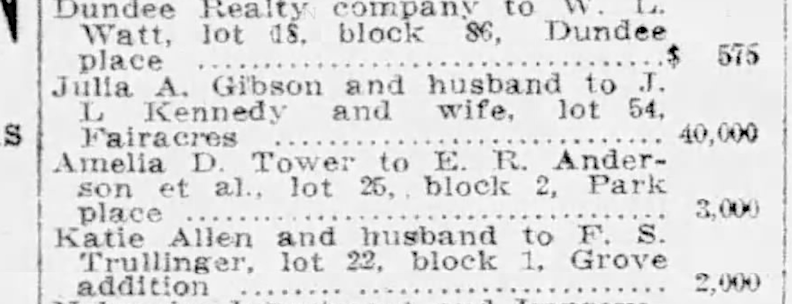
John L. Kennedy, an attorney, bought the Julia Gibson home in Fairacres, paying $40,000 in the winter of 1912. Mr. Ed Gibson died in Douglas, Wyoming in 1913, having returned to the family ranch. The LaBonte Ranch, as it was called, was considered one of the fine ranch properties of the Douglas County, Wyoming. Omaha Bee. February 1912.
From a Far and Lovely Country
John Lauderdale Kennedy was born in Scotland, later immigrating to the United States in 1874. He graduated with a law degree from the University of Iowa in 1882, passed the bar and set up his practice in Omaha. Kennedy served as a Republican congressman from 1905 to 1907 before returning to practice law in Omaha. I believe by the time he was buying the Gibson home, Kennedy was chairman of the Republican State committee. During his time residing in the glorious 6300 Dodge Street home, he was president of the U. S. National Bank and President of the Omaha Chamber of Commerce. At the logging of the 1920 U. S. Census, John Kennedy was 50 years of age. He lived in the mansion with younger wife, Marguerite, sons John and Edward and little daughter Katherine. Maid Wilma Benish and Nurse Anna Nelson lived in the home.

John Lauderdale Kennedy. From one of my favorite books, Nebraskans, 1854-1904. When he retired in 1933, Kennedy moved to Pacific Palisades, California.
Wool Gathering
In the 1925 time period, Rufus E. Lee purchased the John L. Kennedy house in Fairacres for approximately 175 thousand dollars. Mr. Lee is thought to have come to Omaha in 1893 to work for the telephone company. From there Lee transitioned into utilities, specifically gas and electric, serving nearby towns and the whole Midwest region. It was after a surprise resignation and selling control in one of his companies, it was then that Lee purchased the 6300 Dodge house, soon after gaining even more attention for a dramatic orchestration. Mr. Lee announced his Lee Company going forward would deal in investment securities and bought all of the stock of the City National Bank Building company–thereby acquiring ownership of the sixteen story office building at the corner of Sixteenth and Harney.
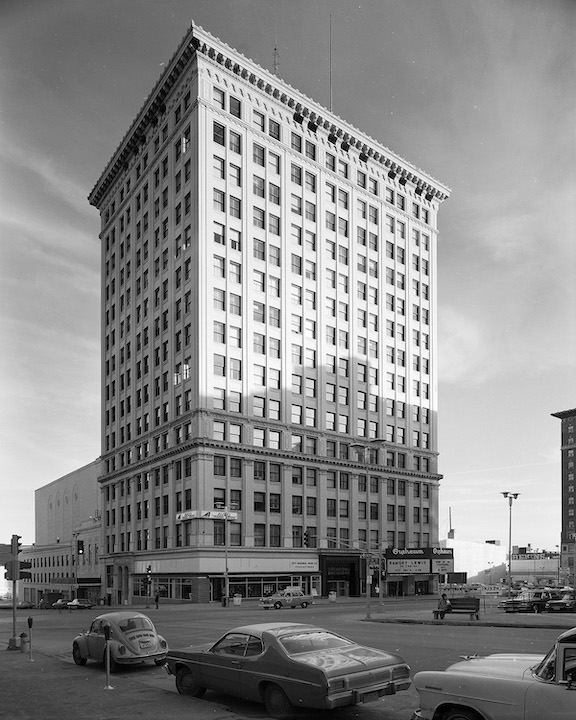
City National Bank Building photo borrowed from the Landmarks site. 405 South 16th Street. Year Built:1910. Architect:Holabird & Roche.
Romanced
In 1925 the Rufus E. Lee family began a major renovation of the three-story brick structure. The addition of east and west sunrooms with second story sleeping porches was constructed. “The imposing two story south veranda with pillars and pilasters featuring the Corinthian capital, gave the simple brick structure a truly Georgian Palladian appearance.”

1925. New two story south veranda with pillars and pilasters featuring the Corinthian capital. New east and west wings. Bostwick and Frohardt, photographers. Durham Museum.
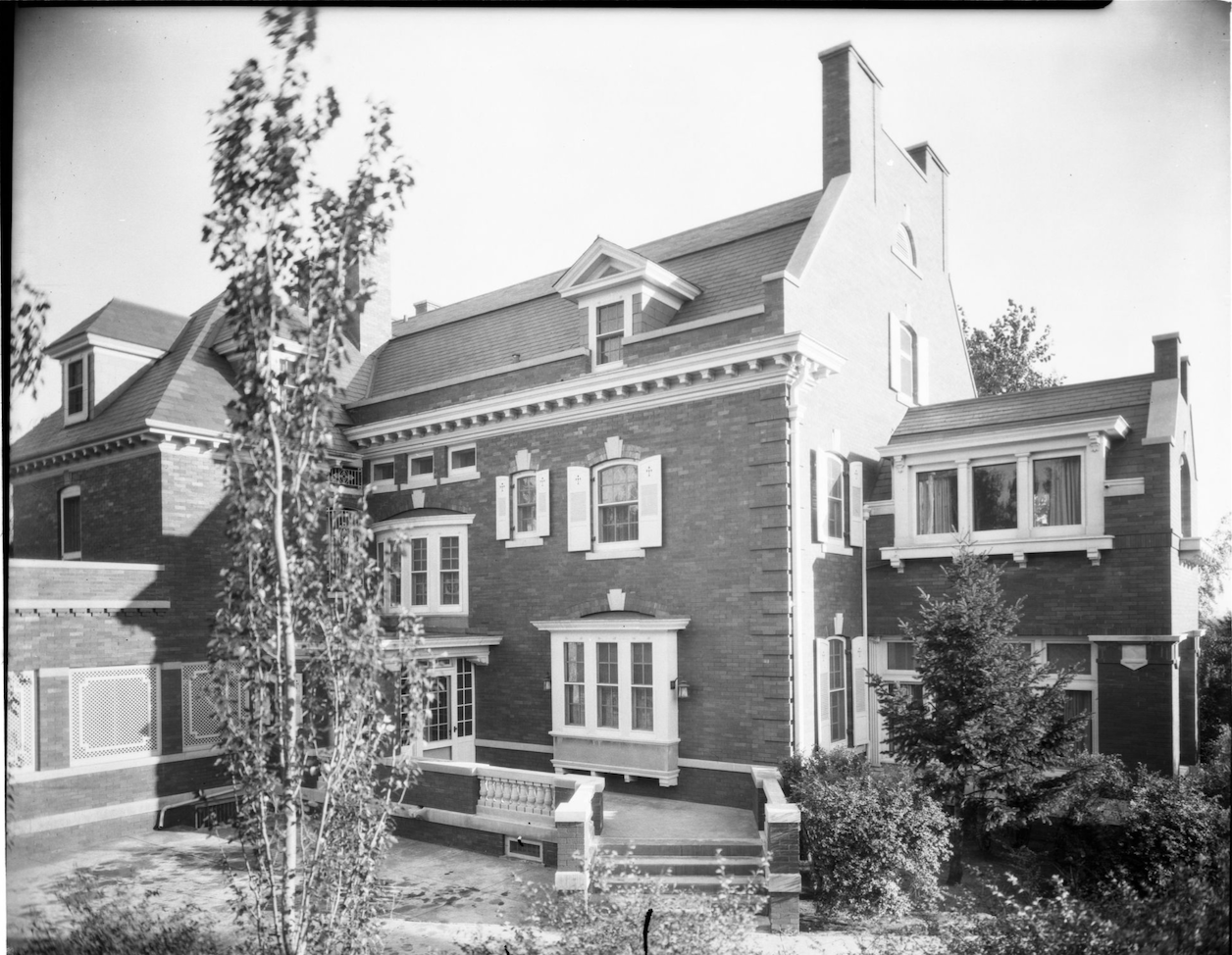
1925. Northern elevation with addition of the west side sunroom and sleeping porch. Bostwick and Frohardt, photographers. Durham Museum.
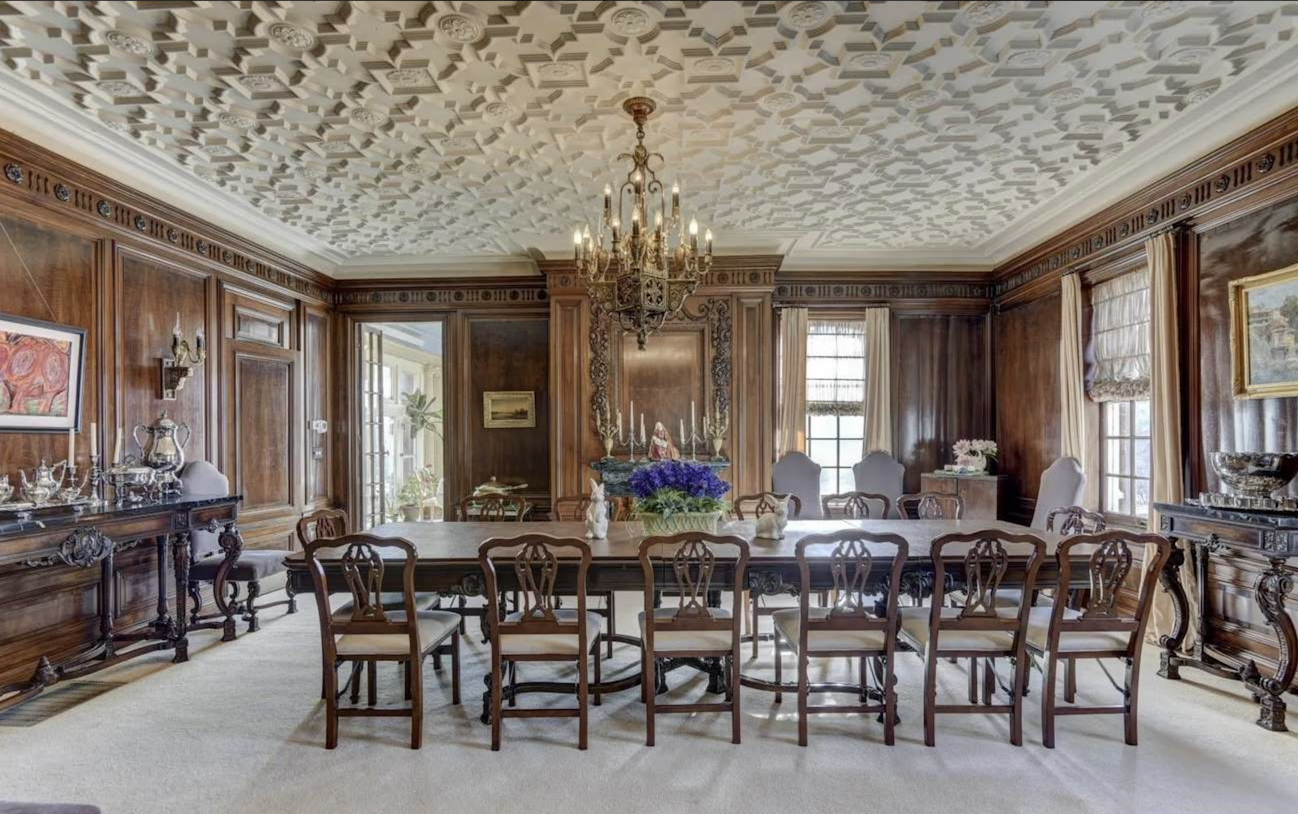
The Lees enhanced the dining room significantly with the addition of the ornate wood paneling. Photo borrowed from the Better Homes and Garden real estate site.
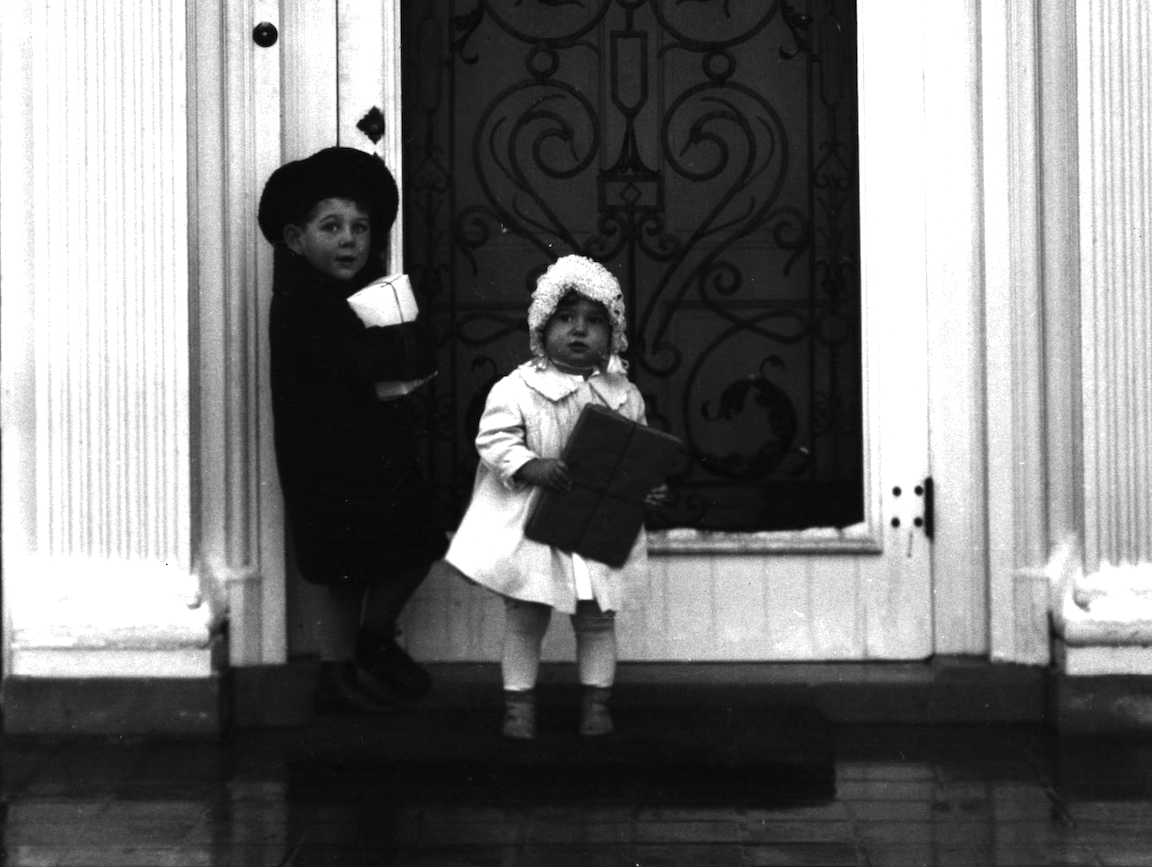
1925. The Lee children at the front door of 6300 Dodge Street. They were listed as Lee’s children but I’ve got to wonder if they were grandchildren.
It was the Lee family that focused and developed what the 6300 Dodge grounds could be– a rolling, spacious fairy land of Secret Gardens. The landscaping design was contracted through a Chicago firm. “To the east of the home, tiers of reflecting pools were constructed all the way to 62nd Street. During this renovation the greenhouse was built and the south lawn featured an elaborate formal rose garden which emphasized a central fountain.”
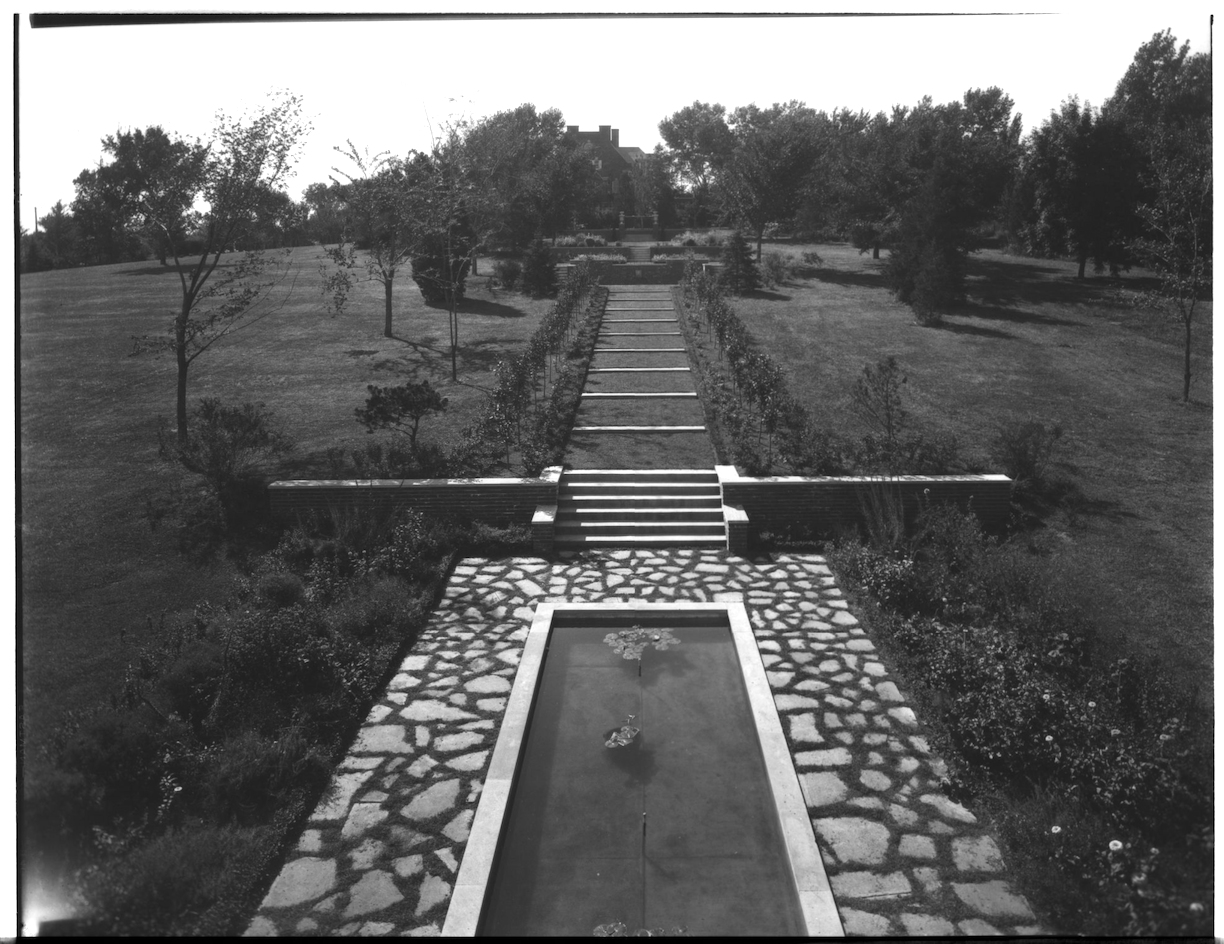
1927: Rufus E. Lee’s mansion property. This is the lily pond in the backyard of the home with several flowerbeds and bushes surrounding it. Bostwick and Frohardt, photographers. Durham Museum. Camera from the eastern edge focused west, back at the house.
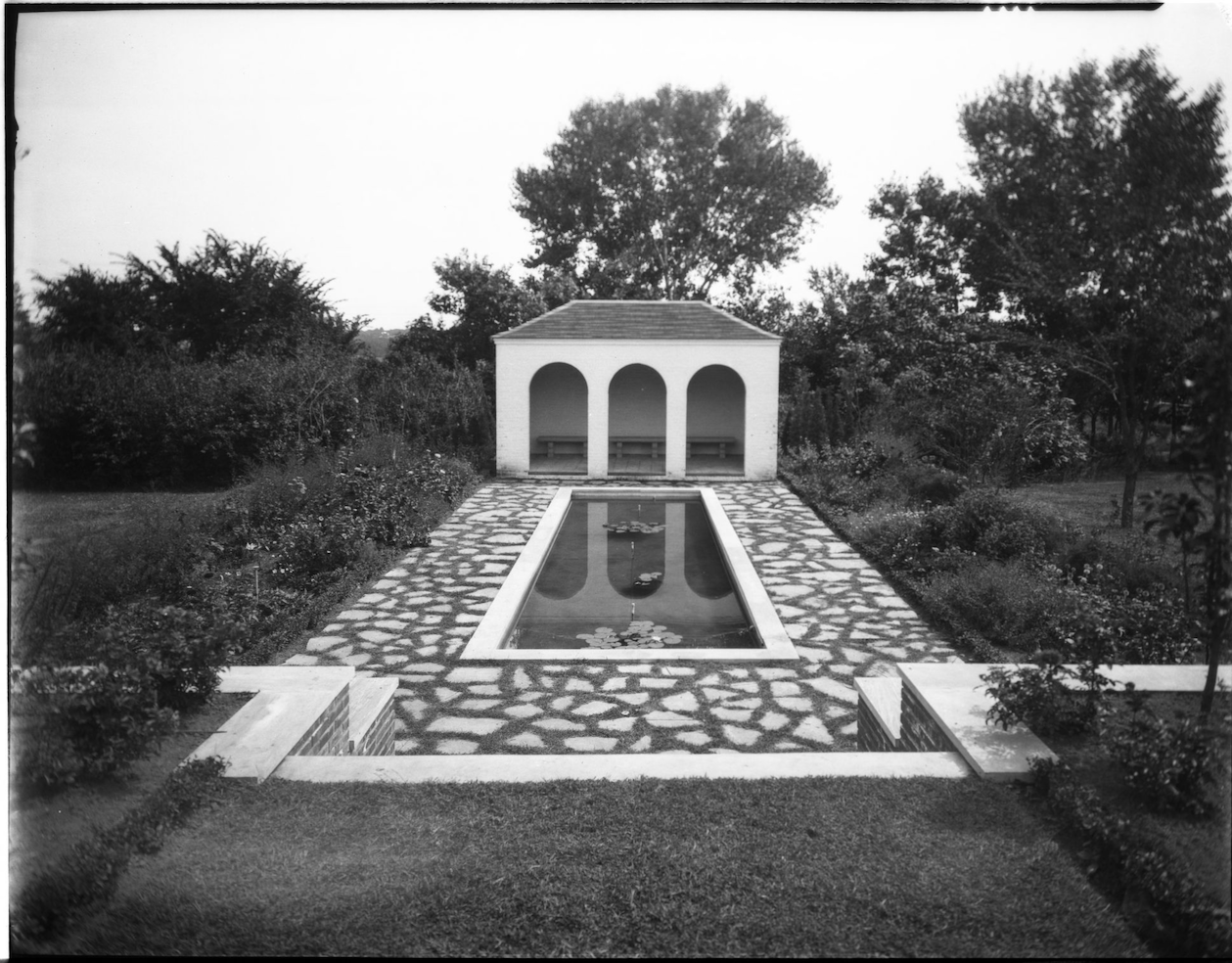
1927: Rufus E. Lee’s mansion at 63oo Dodge Street. This is the lily pond in the backyard of the home with several flowerbeds and bushes surrounding it. Bostwick and Frohardt, photographers. Durham Museum. Camera faces east toward 62nd Street.

Series of greenhouse areas. Photo borrowed from the Better Homes and Garden real estate site.
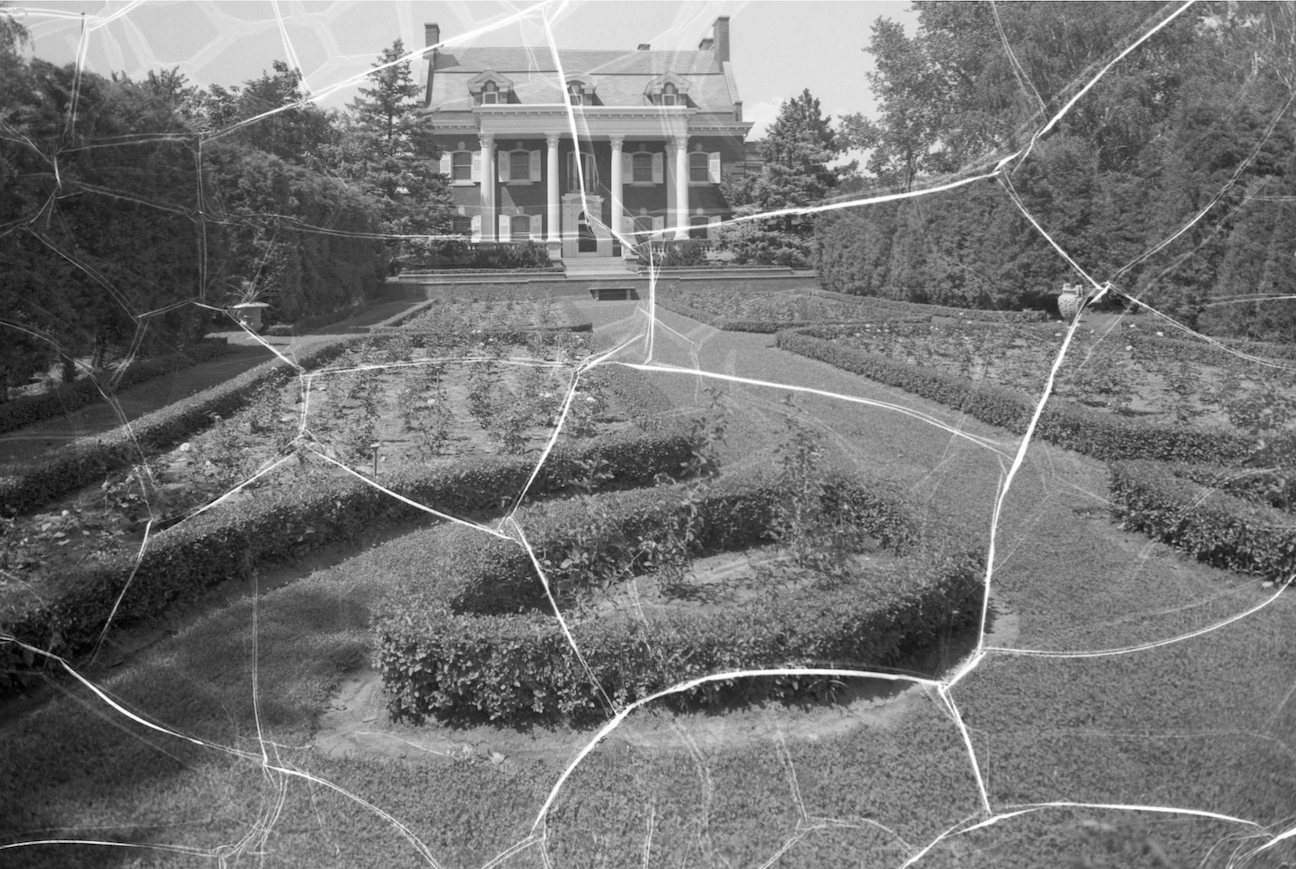
Although this great photograph was taken in 1938, it gives a sublime view of the Lee family’s rose garden and what the southern “front” part of the property looked like. Bostwick and Frohardt, photographers. Durham Museum.
The Lee family not only employed the traditional domestic staff, through the 1930s the large house was served by a gardener, a yard man and a chauffeur.
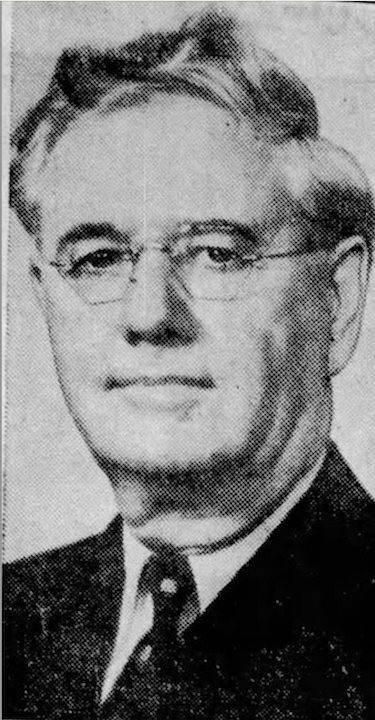
1935. OWH. Rufus E. Lee died at age 61. Known as an Omaha financier. “Prominent Omaha business leader died of heart disease” at the 6300 Dodge home. President of the City National Bank Building company and chairman of the waterways committee of the Omaha Chamber of Commerce. Also organizer and president of Rufus E. Lee & Co., dealing in investment securities. I couldn’t help but wonder if there was a wandering Rufus in the large home.
The Bishop’s Home
Two years later, in 1937, Mrs. Rufus E. Lee died. The Lee daughters, Mrs. Helen Lee Galloway and Mrs. Beatrice Lee Thomas quickly sold the family’s Fairacres estate to the Catholic Diocese for use as the new Bishop’s Home. In a very generous display, the Catholic dioceses announced 6300 Dodge would be residence for Bishop James Hugh Ryan.
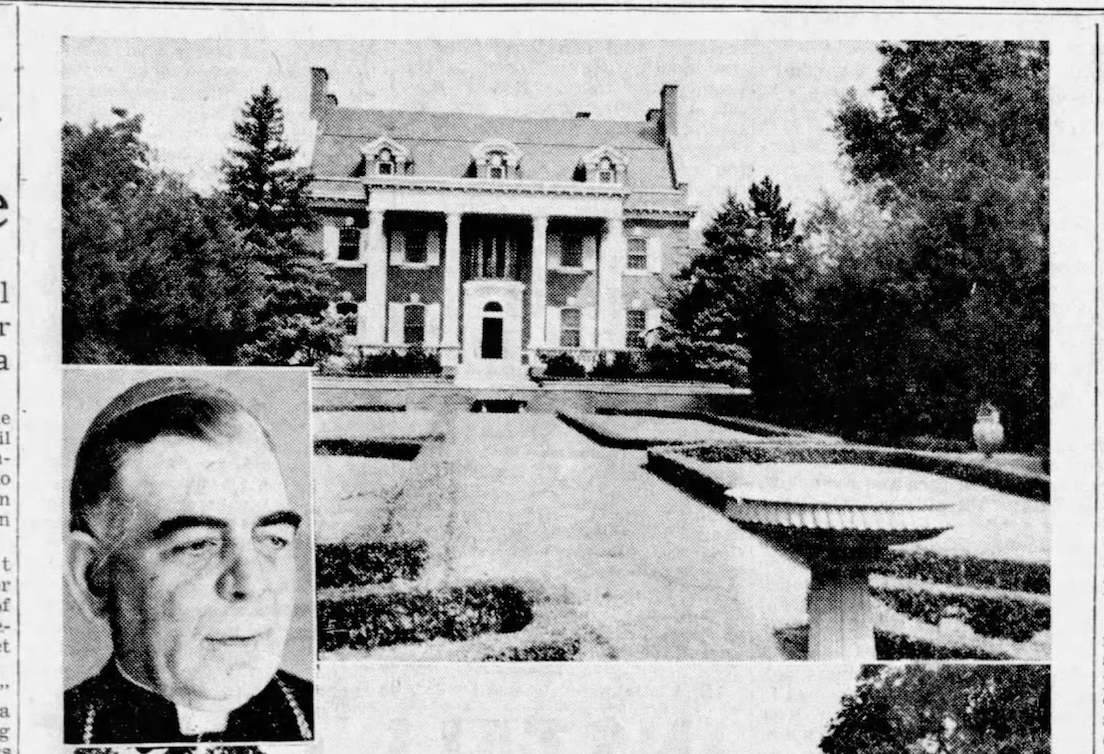
August of 1937. OWH archives. Bishop James Hugh Ryan shown as soon to be new owner.
From my research Bishop was an artistic person, a lover of the arts and enjoyed collecting antiques and architectural salvage. They didn’t call it that back then, but he began filling the mansion with the most savory of things. Leaded glass windows, antique chandeliers and all manner of light fixtures. As if the house was not large enough, Bishop Ryan embarked on an impressive three-story northern wing . The wing included a third-floor dormitory, a chapel with a vaulted ceiling designed using the Omaha Bishops’ hand-painted Coat of Arms, and a sizable library that housed a unique collection of Medieval monastery texts. The leaded hand-painted three-panel atrium entrance on the second floor, the elaborate grillwork hiding the screen on the front door, and the other exquisite religious features throughout the house are all Ryan’s creations.

Bishop Ryan’s addition as shown–a northern wing extends from the main house, with many dormer windows. 2023 aerial shows the addition nicely with outbuildings.

- The home of Bishop Ryan of the Omaha Catholic Diocese. Two workmen are re glazing some of the windows. New wing extends to the north. Camera faces west. Bostwick and Frohardt, photographers. Durham Museum.
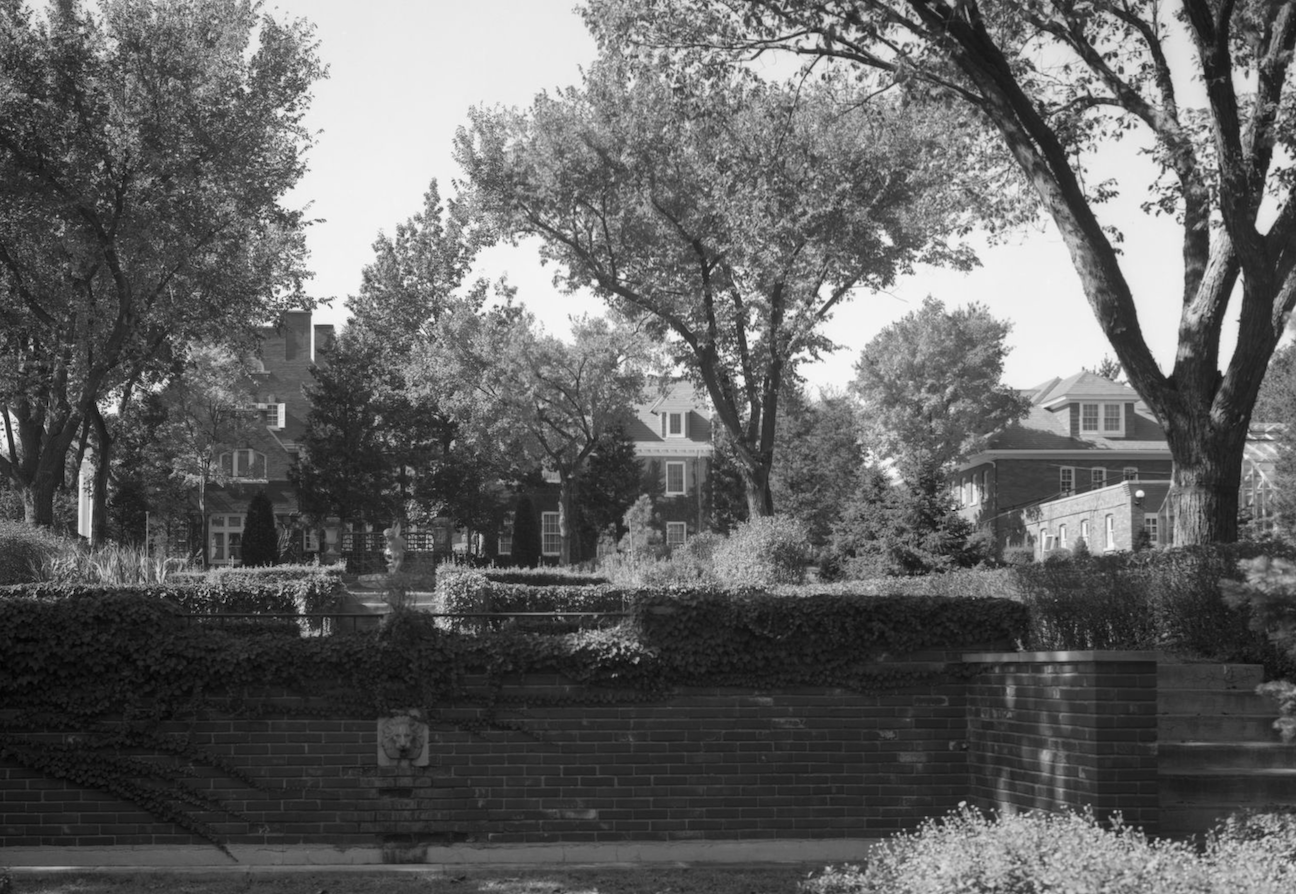
1938. Eastern elevation. New addition to the north. Carriage house to the north. Beautiful wall with fountain in the distance. Bostwick and Frohardt, photographers. Durham Museum.
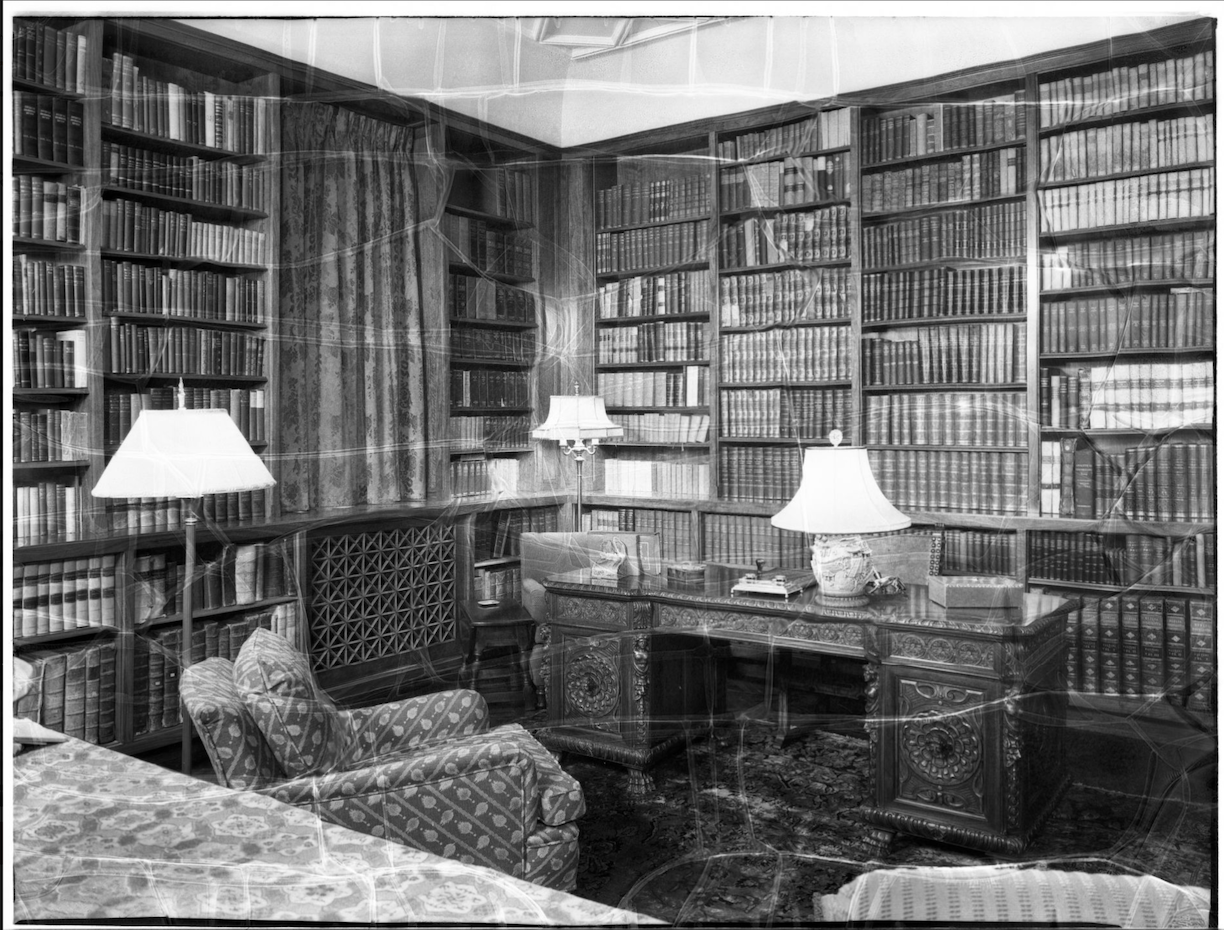
1938. Bishop Ryan’s sumptuous library. Bostwick and Frohardt, photographers. Durham Museum.

A portion of how Bishop Ryan’s library looks today. Divine ceiling and marble fireplace. Take me away! Photo borrowed from Better Homes and Gardens real estate site.
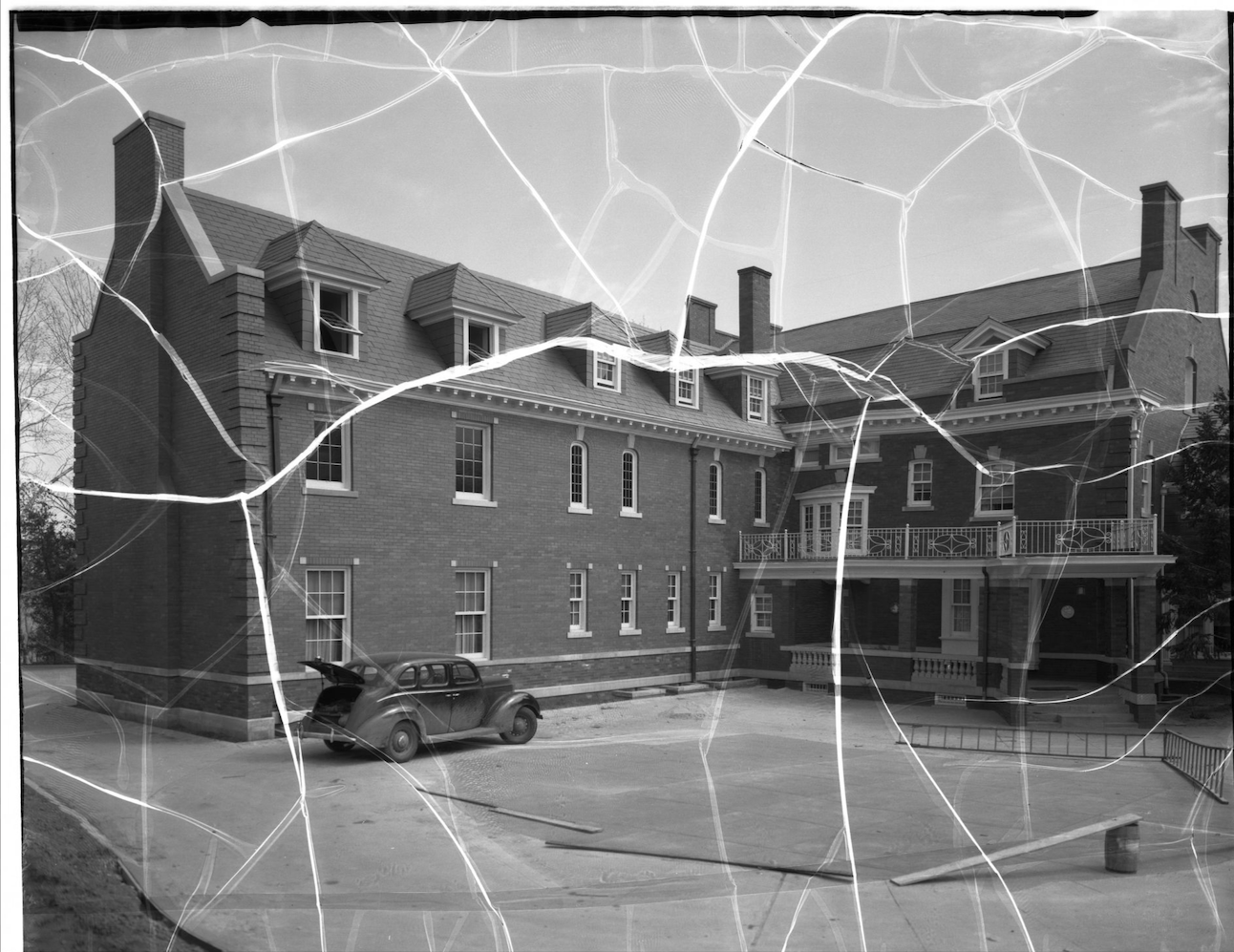
1938. How the northern wing looked from the west side. Quite extensive! Camera faces east. Bostwick and Frohardt, photographers. Durham Museum.
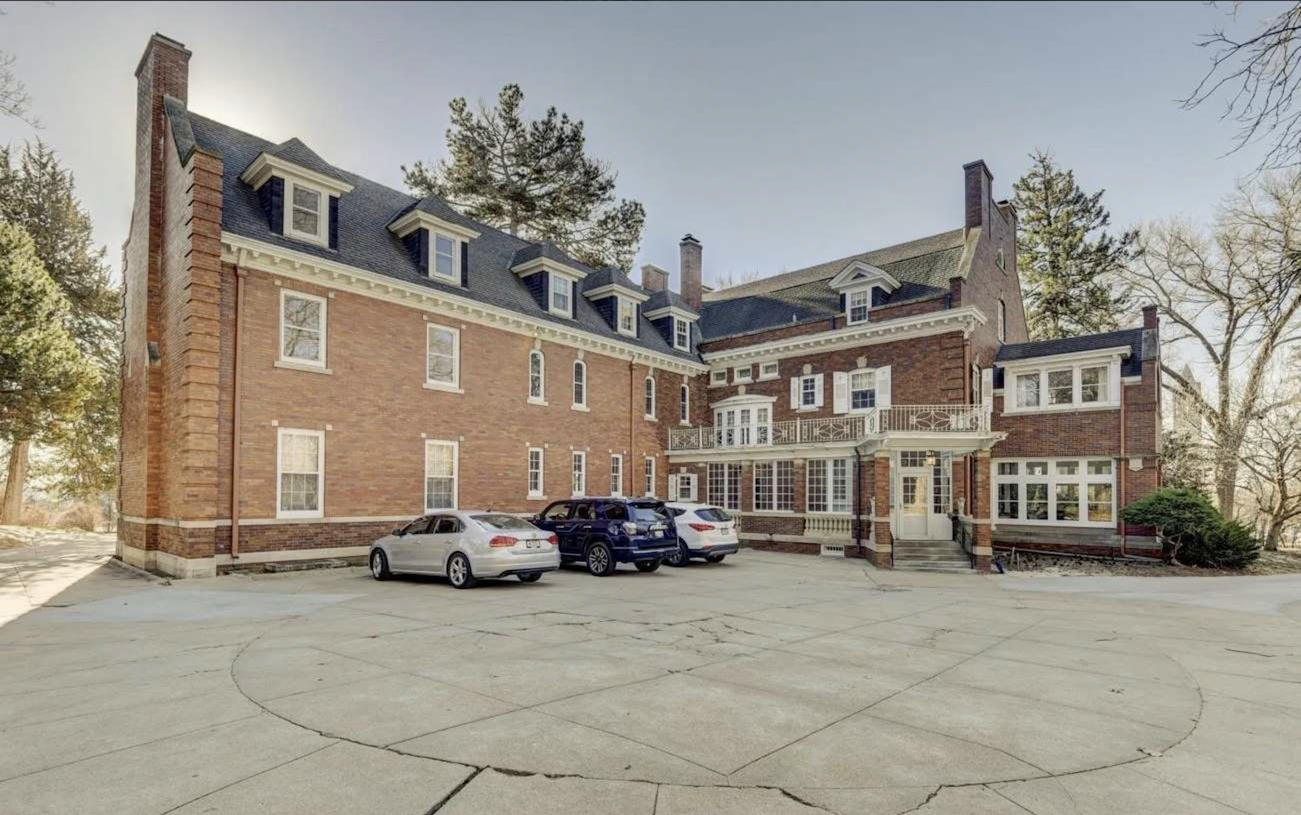
How this same northwest angle looks today. Even better to my eyes. Photo borrowed from Better Homes and Gardens real estate site.
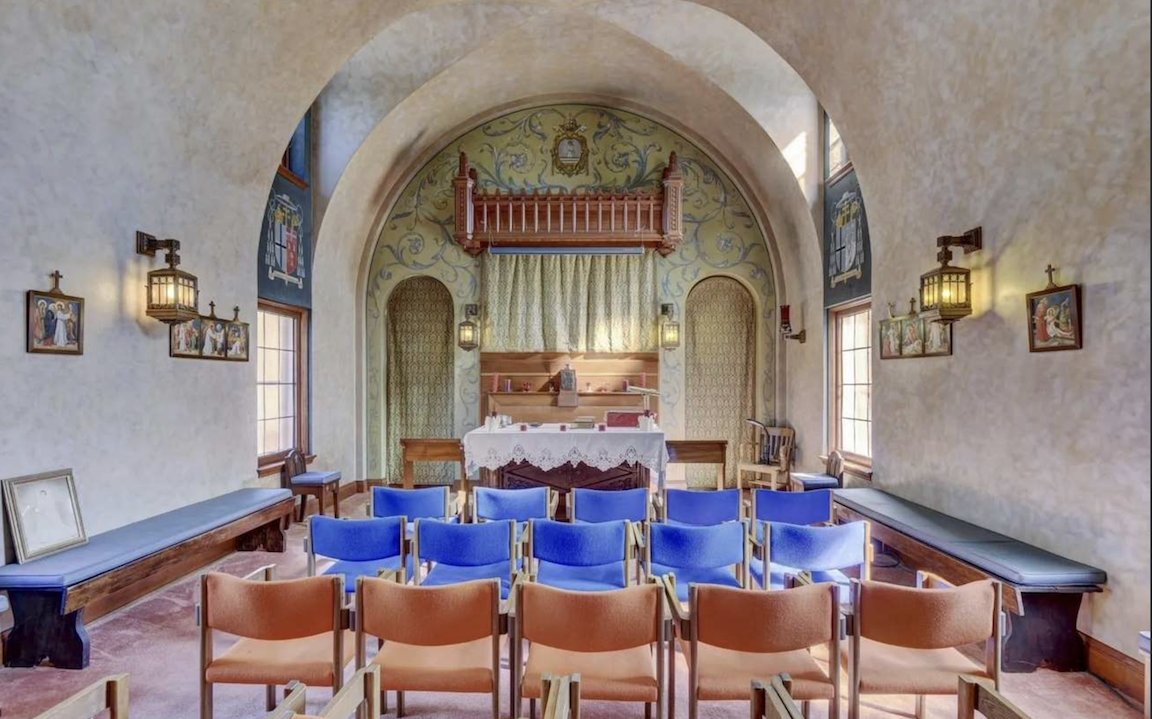
One of the more interesting features of Bishop’s northern wing was the chapel. The photo doesn’t do it justice. Photo borrowed from Better Homes and Gardens real estate site.
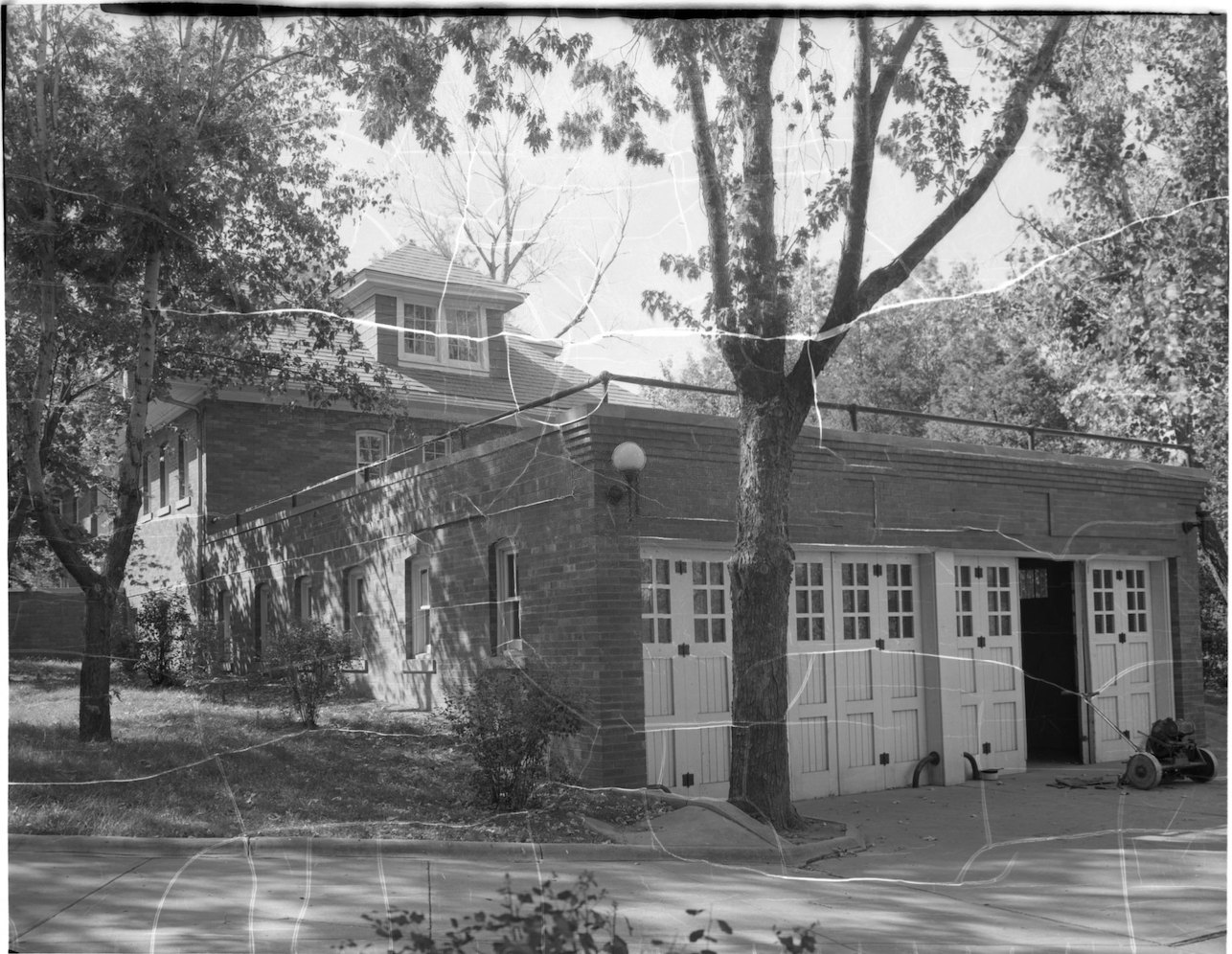
1937 carriage house. This building alone is a wondrous structure. A fire place and great accommodations, this most likely housed some of the large staff in the Lee days. Camera faces a northwest angle. Bostwick and Frohardt, photographers. Durham Museum.
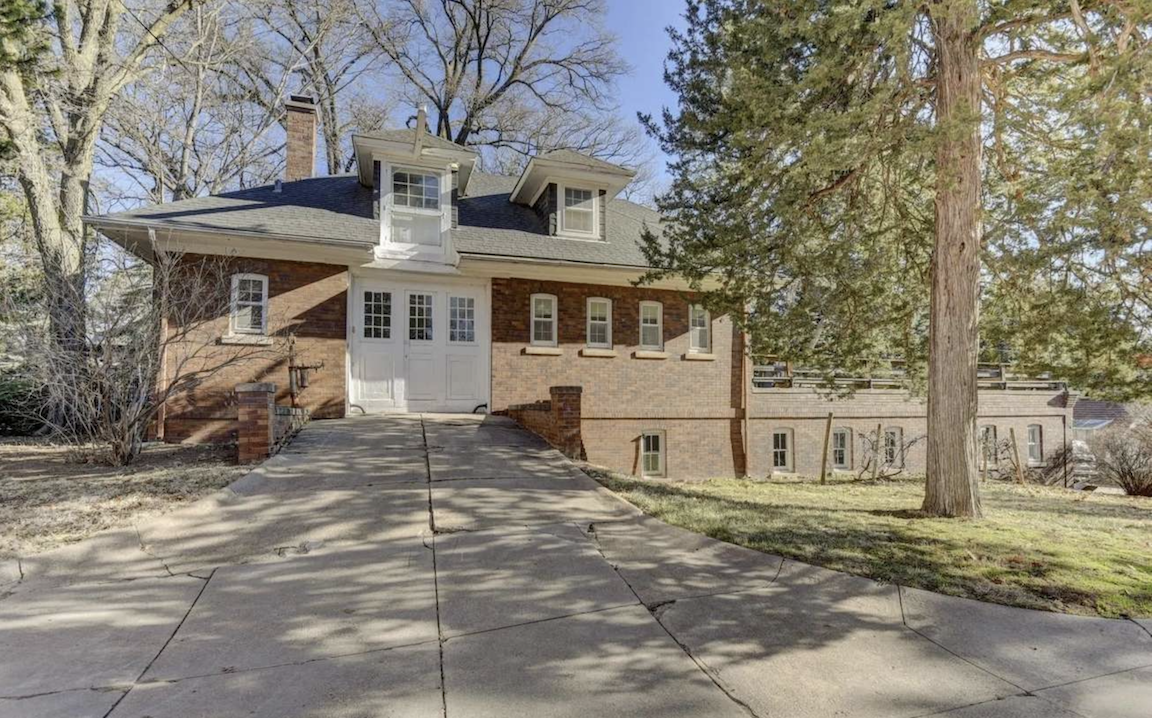
A current photo of the carriage house. Finished 1,600 square foot. Amazing. Different angle than previously shown of the carriage house. The camera faces straight north on this one. Photo borrowed from Better Homes and Gardens real estate site.
When Archbishop James H. Ryan “spent time in the luxuriant October sunlight,” walking through his rose garden in a “simple black cassock, with purple pipings,” enjoying an “after-breakfast cigar,” his dogs, Buddy and Peggy barked. “His dogs can’t understand,” the strange article explained. Everyone knows that dogs do understand all of this madness. The year was 1945. I relished any descriptors of Ryan’s personal life. Oddly I found that Bishop Ryan’s brother’s mother in law lived in the large 6300 Dodge Street home with him. She passed away in a Council Bluffs hospital while living there. I understand that this was an exceedingly large home for a lone man, but I wasn’t aware that Bishops could live with family or extended family for that matter. I began to wonder if his brother and sister in law and who else might have hung their hat there?
Great Expectations
In and around 1948, I tracked Archbishop Gerald T. Bergan to 6300 Dodge. He “conferred honors in a private ceremony in the chapel of his residence” and hosted many gatherings. Interestingly after Archbishop Bergan’s leg was severed in 1967, an elevator was installed in the home. By 1971 Fr. James R. Cain announced Bergan had moved into the St. Vincent’s Home for the Aged for retired priests. He had lived in the 6300 Dodge mansion for 23 years. He died in July of 1972. For some reason the Catholic diocese announced the longtime priestly residence at 6300 Dodge Street would be sold. Why did they want to sell when they didn’t have to pay taxes? With the changing times, was this conspicuous consumption frowned upon? I am sure the costs were insurmountable, regardless.
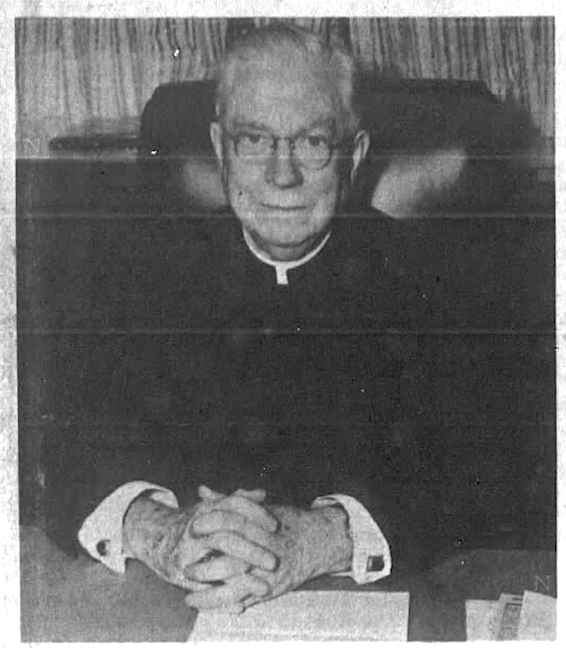
Archbishop Gerald T. Bergan. 1969. The Omaha Catholic Voice.
The Brandeis Matter
There is one concern, instrumental to what is currently happening right now in 2024, that we did not discuss. Across Fairacres Road, at 6412 Dodge Street, there was a phenomenal 10-acre estate. George Brandeis and his wife, Mary Rogers Brandeis bought the property back in 1911. The home and its grounds were considered a showplace and an Omaha landmark. This was the forerunner–this is why there is a brick wall along Dodge Street, just to the west of 6300 Dodge. It currently runs the extent of the Fairacres Condominiums but originally this brick wall girded the Brandeis home. (I’ve got it on a good source, that this brick wall is tuck pointed regularly in recent years because people continue to drive into it, but you know what I mean.) Mr. Brandeis, a former King of Ak-Sar-Ben, died in 1948 at that very Dodge Street home and his widow, Mrs. Mary Rogers Brandeis, died in 1969 following a long illness. Two local nephews inherited the large property. Alas the nephews did not see fit to live there and/or maybe could not afford it. In 1971 the Brandeis house was razed. Old Home House Lovers made a stink but as usual, in these situations, no single families stepped up to purchase. The location of the land was worth more. It would sit as an empty lot until 1977.
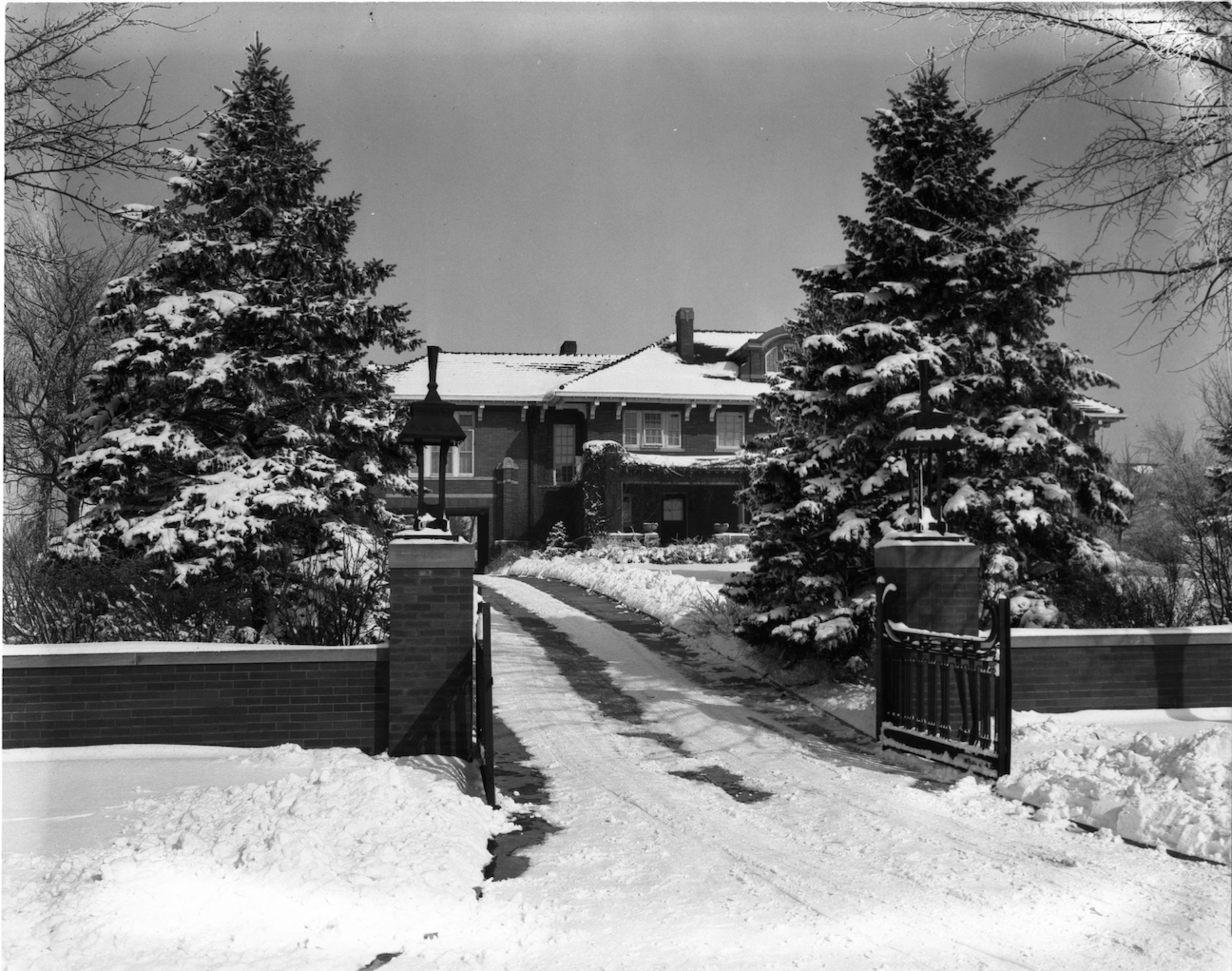
1924. Brandeis home, gracious and special. 6412 Dodge Street. Bostwick and Frohardt, photographers. Durham Museum.

1929. Brandeis home, gracious and special. 6412 Dodge Street. Bostwick and Frohardt, photographers. Durham Museum.
The Tiff
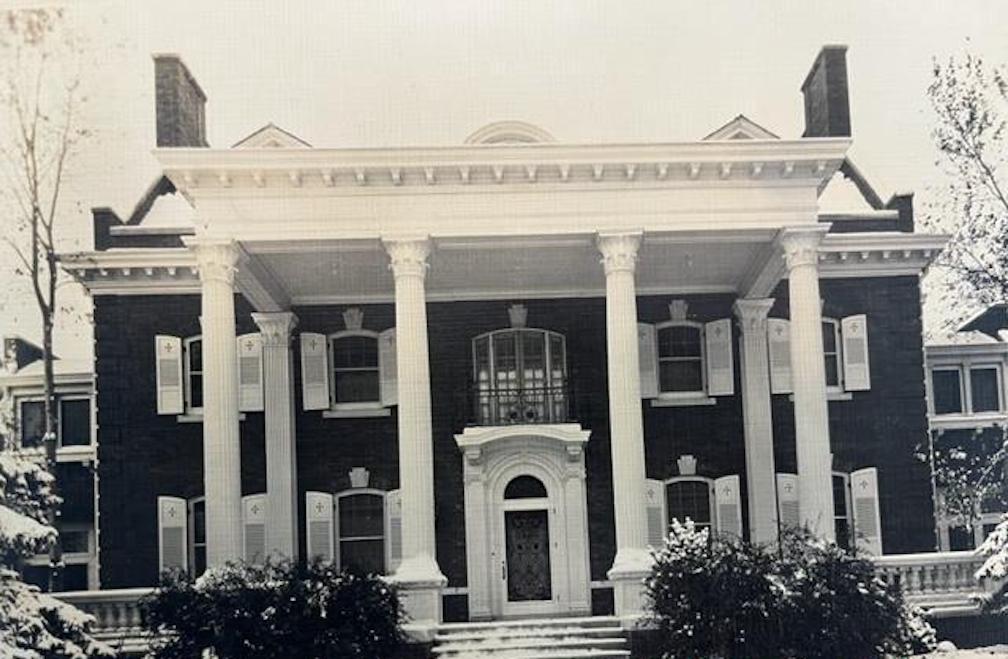
When the Catholic diocese put 6300 Dodge on the market in 1971, the large property had been cut back to “about four acres.” Of note, the Catholic Archdiocese had a new building on the eastern part of the property, with a drive off of 62nd Street. What was once the Archdiocese building, an award winning architectural feat next door to the east, at 100 North 62nd Street, is now owned by St. Margaret Mary’s Church.
I found this interesting. In April of 1972 the Fairacres neighborhood opposed expansion of UNO across Dodge Street, especially if new land would be used for a surface parking lot. Mrs. Norman Batt was President of the Citizens Action Association, which also opposed acquisition of land west of the campus. I have covered this expansion and loss of, essentially, the southern portion of Fairacres in previous articles. Board of Regents member Robert Prokop suggested the regents consider purchasing the site of the former Brandeis home at 6412 Dodge Street and the vacated former home of Archbishop Gerald T. Bergan at 6300 Dodge. The asking price for the four-acre site of the Archbishop’s home was about $195,000. The land was owned by the Archdiocese of Omaha. The seven-acre Brandeis property was expected to sell for about $350,00. The previous year the regents had bought four estates totaling about $770,000 to the west of UNO. 6300 Dodge could have been leveled back in 1972. Strange plans would come up again very shortly.
A Forever Family
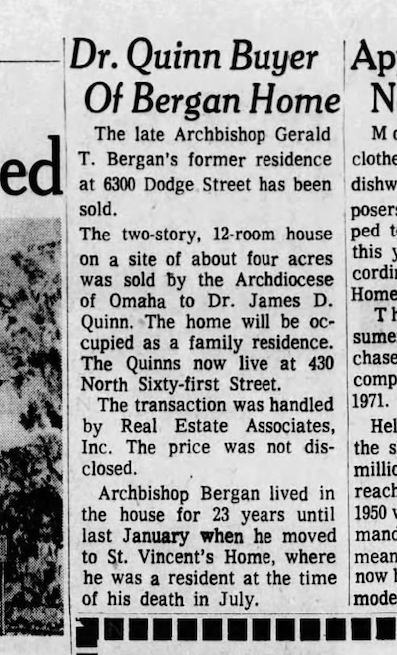
In October of 1972, Omaha cheered as the 6300 Dodge once again became a family home. “Moving to larger quarters last week were Dr. and Mrs. James Quinn and their children, Jimmy and Mary Beth 11-year-old twins, Sean, 10, Kathy 8, Colleen, 5 and Kevin, 4. They are getting settled at 6300 Dodge Street, the former archbishop’s residence, just a few blocks from their previous residence at 430 North Sixty-first Street.” Jim and Betty Quinn were home. OWH archives. October of 1972.
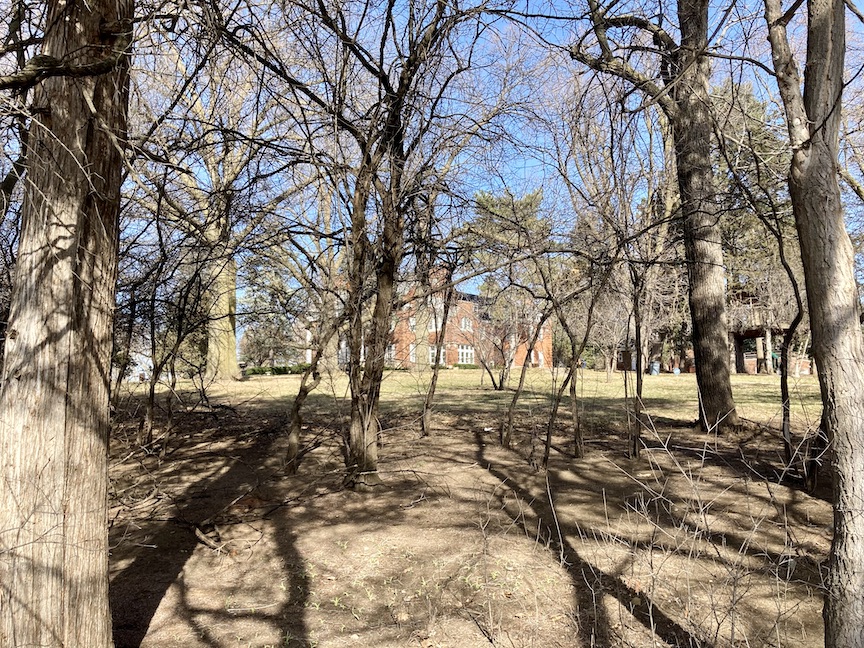
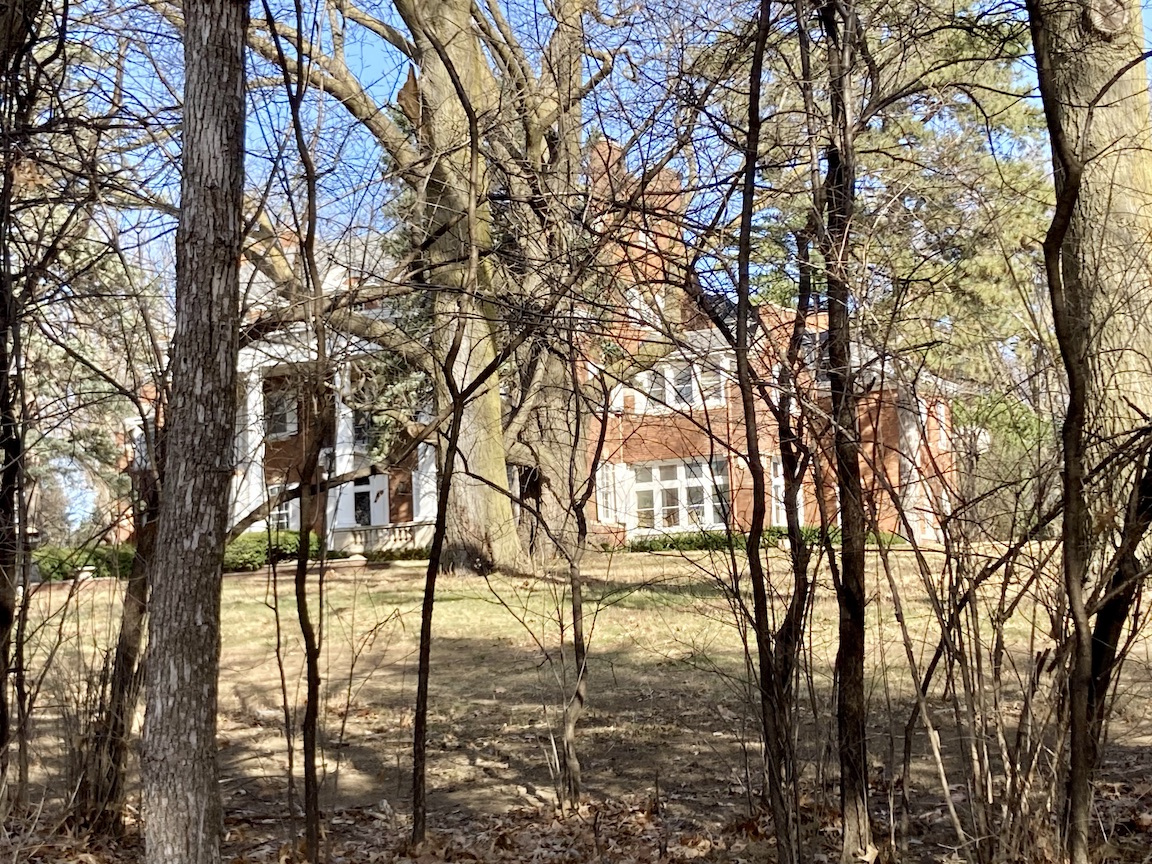
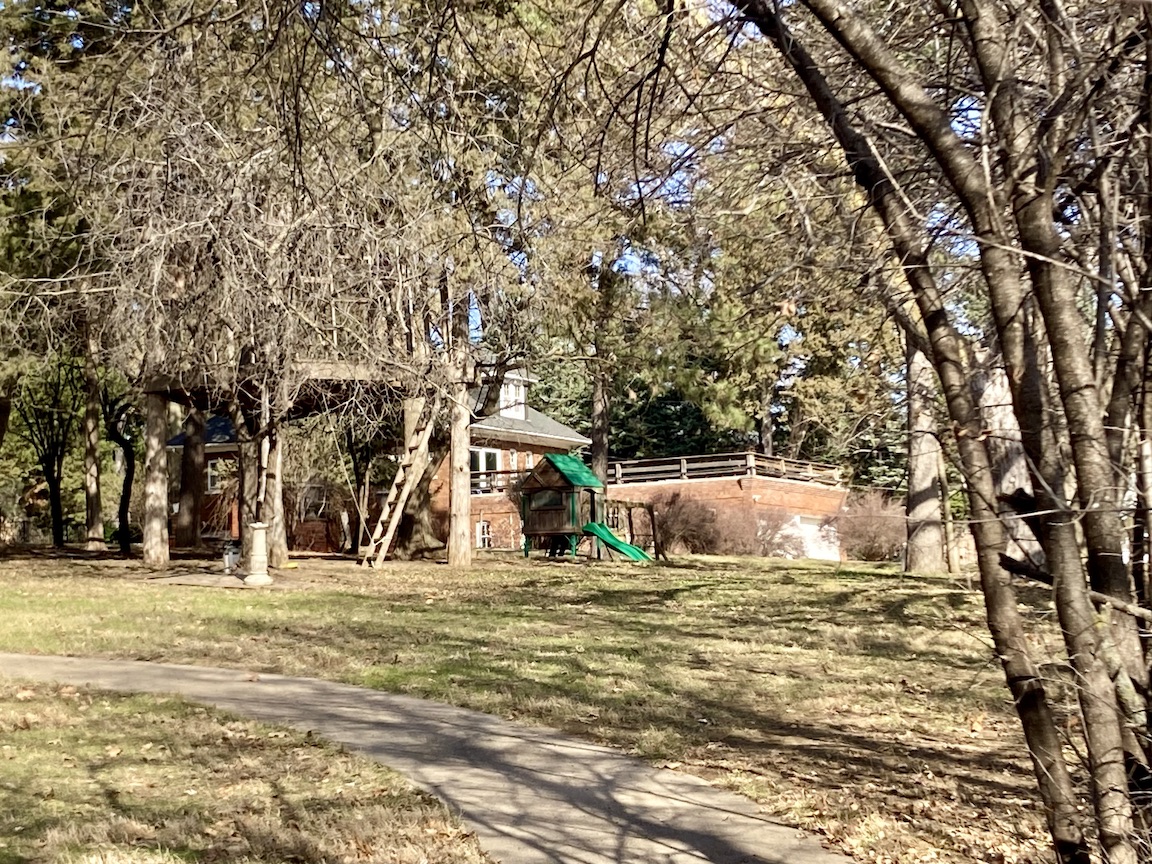

Over the years playground type equipment, a fort and a fence connecting the property to the Diocese building have emerged. Or maybe there was always a sense of connectedness with the Diocese.
The Neighbors to the West
The neighbors may have fought off UNO, but in October of 1977 the Brandeis home site was sold for “Luxury Condominiums.” 6412 Dodge sold and plans were to build luxury condominiums on the five-acre tract. Where did the other two acres go? Don Backman bought the land for $200,000 from the estate of Mary Rogers Brandeis, widow of George Brandeis. Backman planned a joint venture with N. P. Dodge Co. Initially in talks for “30 units,” “super posh” going for $85,000 to $110,000.”The purchase is contingent on getting the property rezoned from its present fourth residential or single-family, classification to seventh residential, or apartment zoning.” See earlier photos of what they ended up with.
“All right, Mr. DeMille, I’m ready for my close-up”
Our 6300 Dodge was picked as the 1984 Designer Showcase house. We did not attend that year. The showcase event was sponsored by the Omaha Symphony Guild and the Nebraska-Iowa Chapter of the American Society of Interior Designers as a fund raising project for the symphony.

Approximately $100,000 of the $250,000 remodeling costs of the Quinn home were paid by the Quinns and the remaining $150,000 by the interior designers. Of note, in June of 1984, Mrs. Quinn, real estate agent, put the 6300 Dodge home on the market. The listing was for $825,000. “We decided to sell the house last fall because it’s too big for us, now that only two of our six children are living at home.” It was said that four houses in the 10 year history of the Omaha showhouse project were sold within six months to a year after they were on display. The article also educated that people wanted to have their homes as Showcase houses for selling purposes. Somehow, I missed that information as a child. I thought it was just offered as a wondrous tour of architectural majesty.
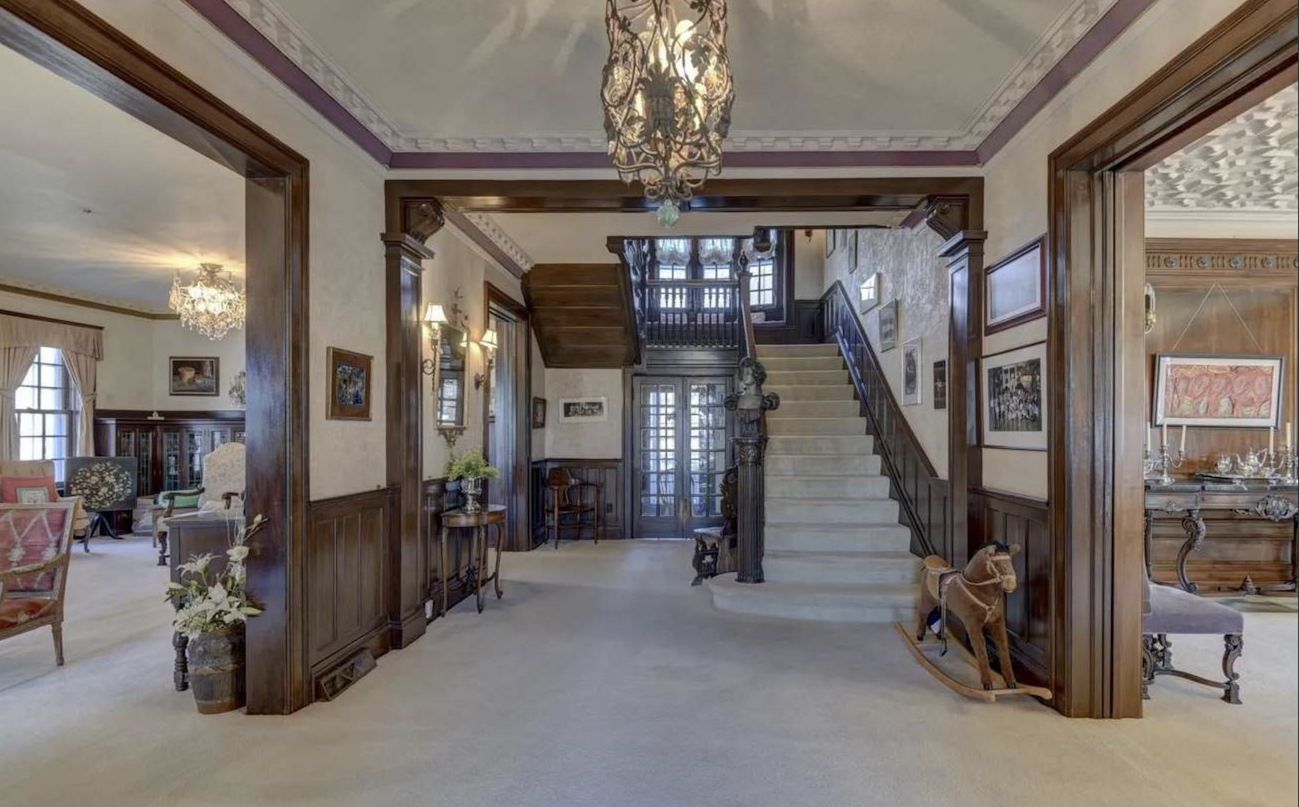

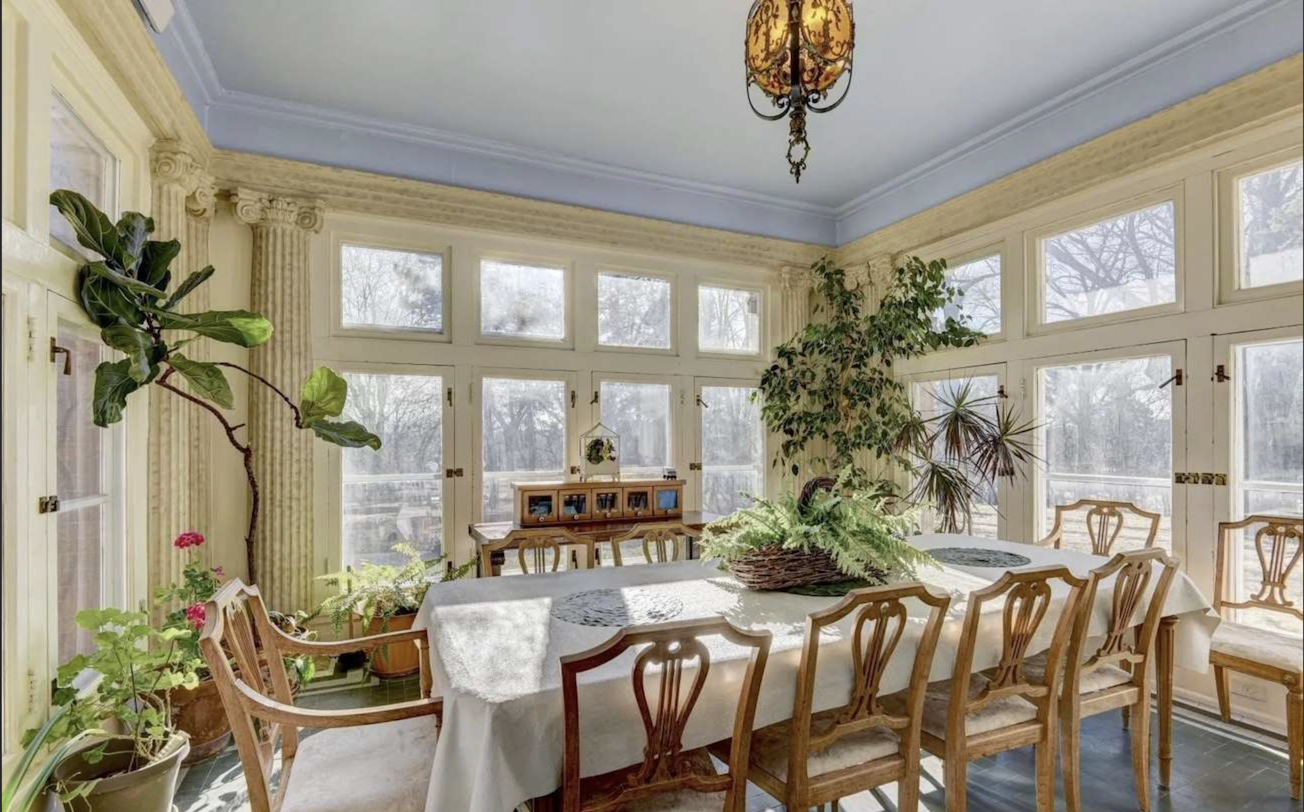
These rooms must have dazzled the Showcase lovers. Another chance to see Bishop Ryan’s antique light fixtures.

A favorite haunted newspaper print photo of 6300 Dodge. So Gothic.
The Mysterious Fairacres Court Plan
In 1985 City Planning Director, Marty Shukert, brought forth a proposal to move three homes from the path of UNO’s westward expansion onto a 3.8 acre estate at 6300 Dodge Street. This was during the time that Mrs. Quinn was trying to sell the property. The proposal was thought to “save architecturally significant homes” and would preserve the character of the Fairacres neighborhood. UNO had acquired the large brick homes from private owners and had announced that they will be razed if someone doesn’t purchase and move them. A three-man partnership seeking nearby property on which to relocate the houses offered the Quinns $600,000 for their 27 room home and 3.8 aces property. The partners proposed creating a “Fairacres Court” by moving onto the Quinn property three or four of the homes scheduled for demolition. Total investment was thought to be $1.5 million. In a creative plan, the partners wanted to place the houses on the corners of the Quinn estate, facing the 11,000 square foot Quinn home. A brick wall would be built along Dodge and wrought iron fence would be erected on the other sides.
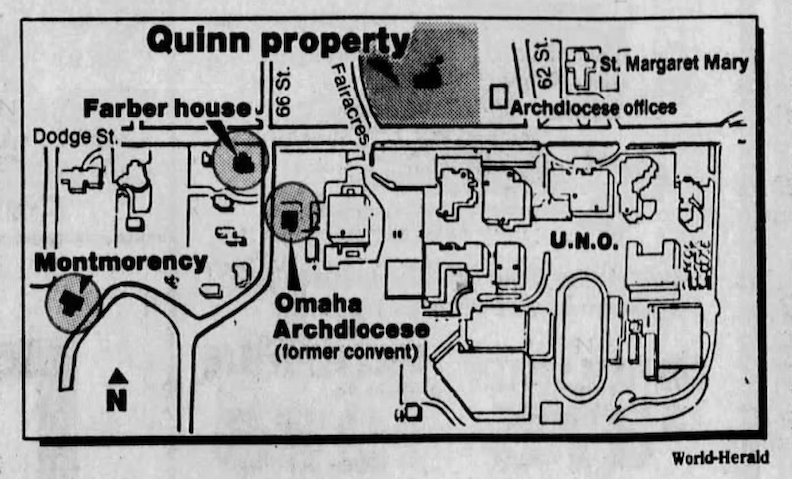
1985 diagram from the OWH.
The Farber house at 104 South Elmwood Road and two others, (the Montmorency and the Omaha Archdiocese convent) would make up “three of the most significant structures” to be moved to the 6300 Dodge Quinn parcel.
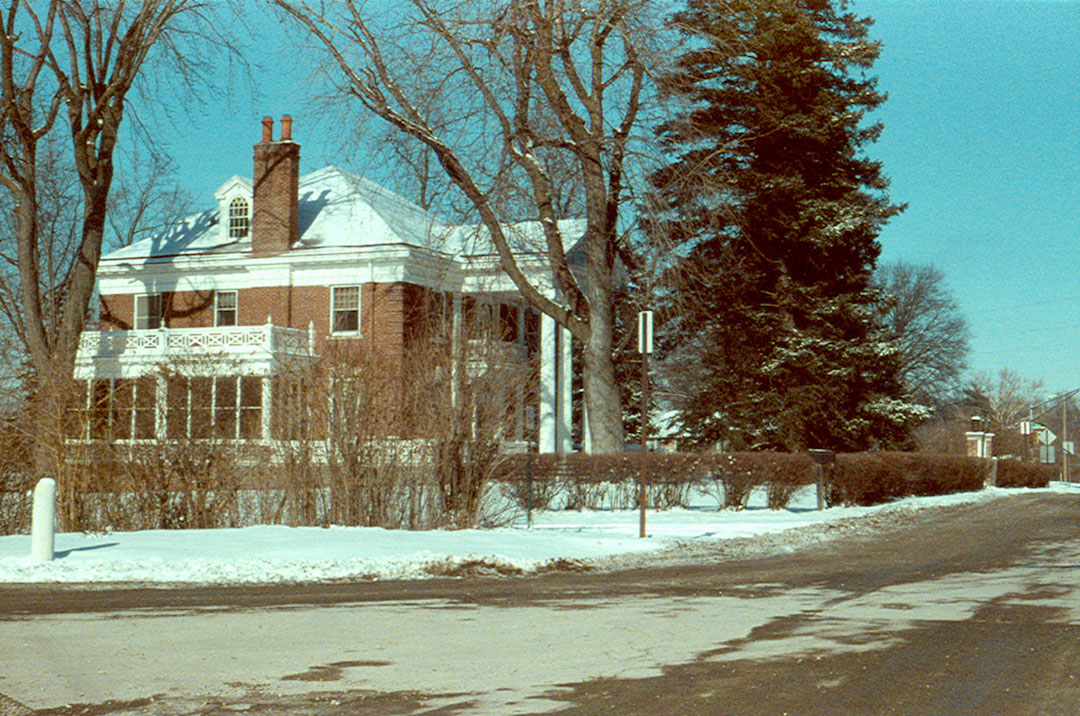
The Farber home was the only one that I’ve traced at this date. The others I show here were not to be moved but I share them to give an example of the kinds of homes that were demolished. I have an article I’ve been working on for a million years called The Neighborhood That Disappeared. This photo and the following are from that case. I would have nothing to show for my work, had it not been for the forward thinking of photographer and archivist, Les Valentine. Thank you.
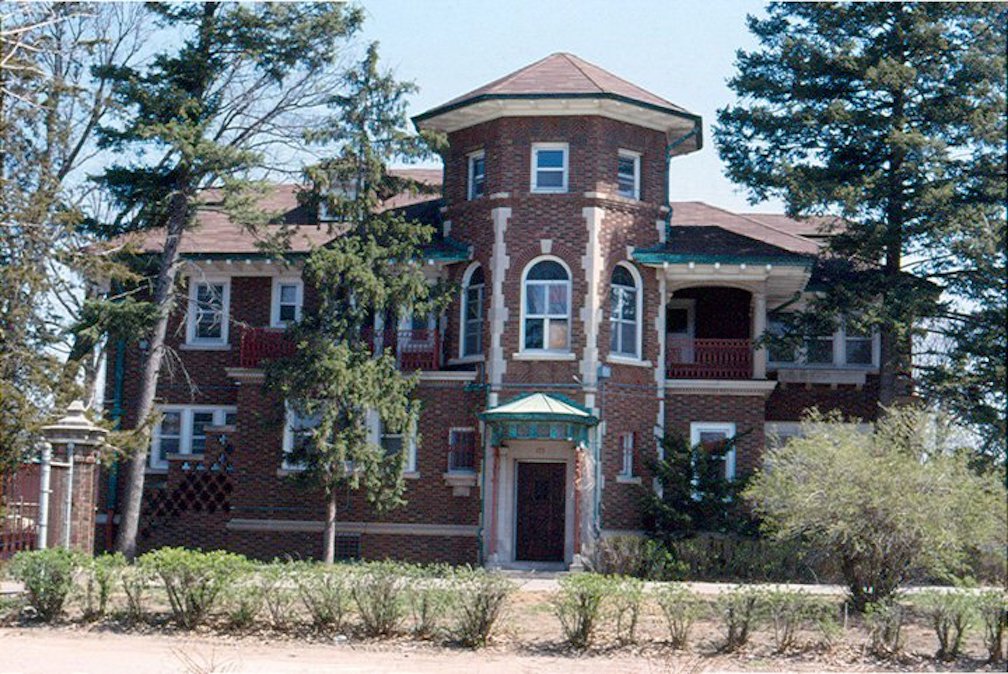
The fascinating Madden house.
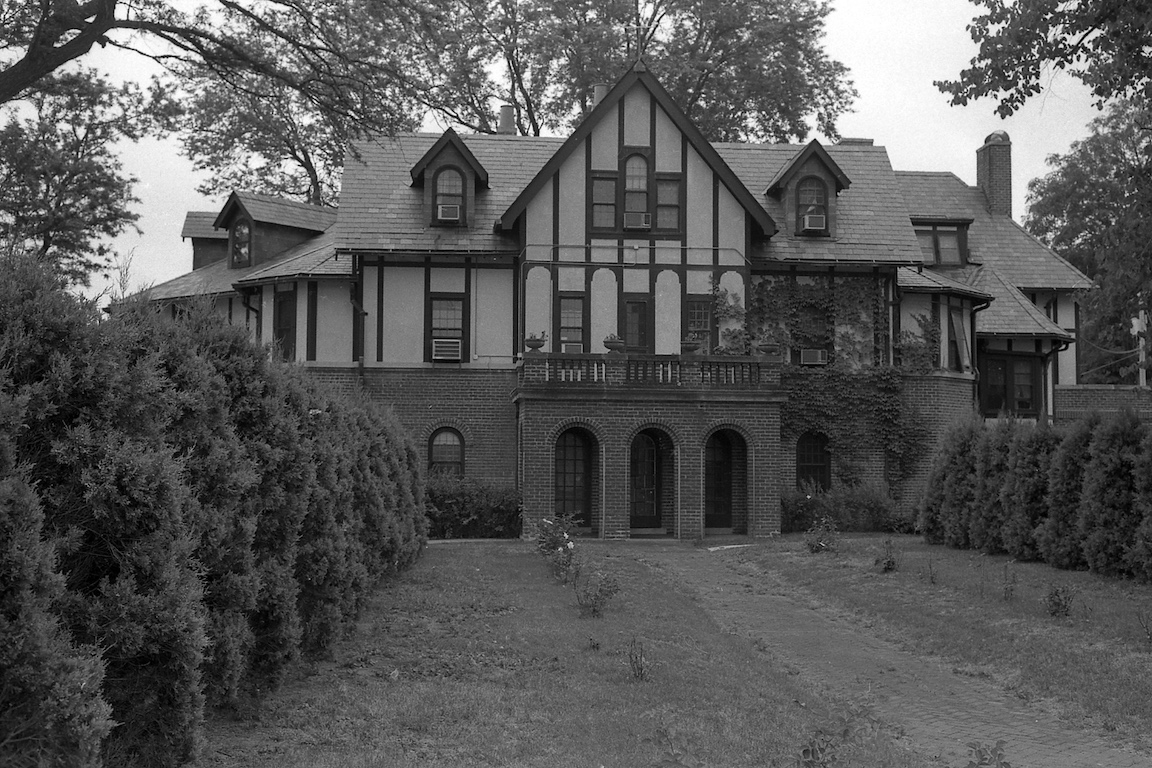
The Storz mansion, insanely cool.
As evident, Dr. Quinn turned down the $600,000 offer “because he was only given a few days to make up his mind.” The Quinns had listed their home on the market for $825,000. City Planner Skukert liked the idea because “it would assure that a high density multifamily development would not be proposed for the (Quinn) property by a developer wanting to buy the Quinn property for such a purpose.” The Quinn estate was zoned first residential, calling for single-family homes on large lots. Unfortunately, according to Dr. Quinn “they had a workable project and the time constraints were too short to put together an agreement that was satisfactory to both parties.” Attorney Jahn said the real estate developers who advised the partners told them “It would be highly imprudent” to pay the Quinns more than $600,00 for the estate.
In the prophetic words of Landmarks Inc attorney, Gregory Jahn, “Land cost begins to dictate a developments’ density and that can create a problem.” Jahn said he fears “the estate will be turned into a multifamily development such as Fairacres Place, a condominium development on the former Brandeis estate on the north side of Dodge, just west of the Quinn property. Chances of an 11,000 square-foot house on 3.8 acres of land remaining a single family residence are slim. It’s kind of an envelope in time that’s delivered once in a lifetime to get something like this done.” It was a stunning loss and perhaps too bizarre of a plan for Omaha, certainly the Quinns, who felt rushed to decision.
The problem had returned, just as predicted back in 1985.
This just in. **Addendum of October 19, 2024.
1943 journalist, in writing about Omaha City Planning, speculated that Fairacres had all the makings of a future “slum.”
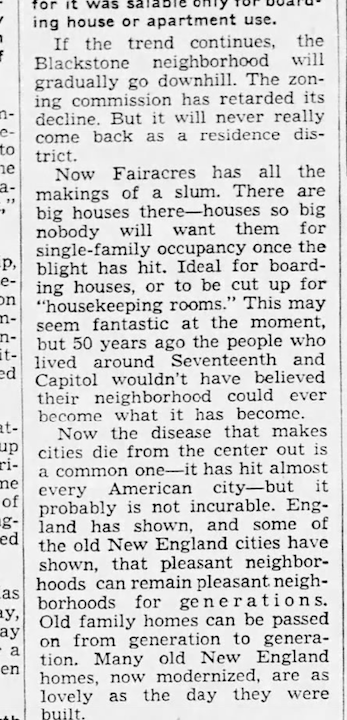
July 9, 1943. Evening World-Herald.
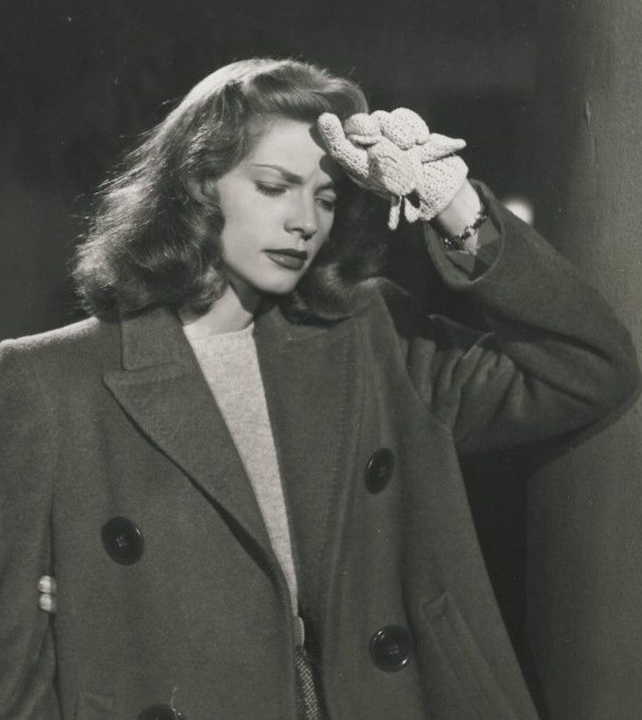
Now I really must get back to the current investigation at hand. Well…maybe just one more slice of Lithuanian Bakery torte.
As always, keep those peepers popped.
Miss Cassette
This article is dedicated to Dr. Quinn and The Informant.

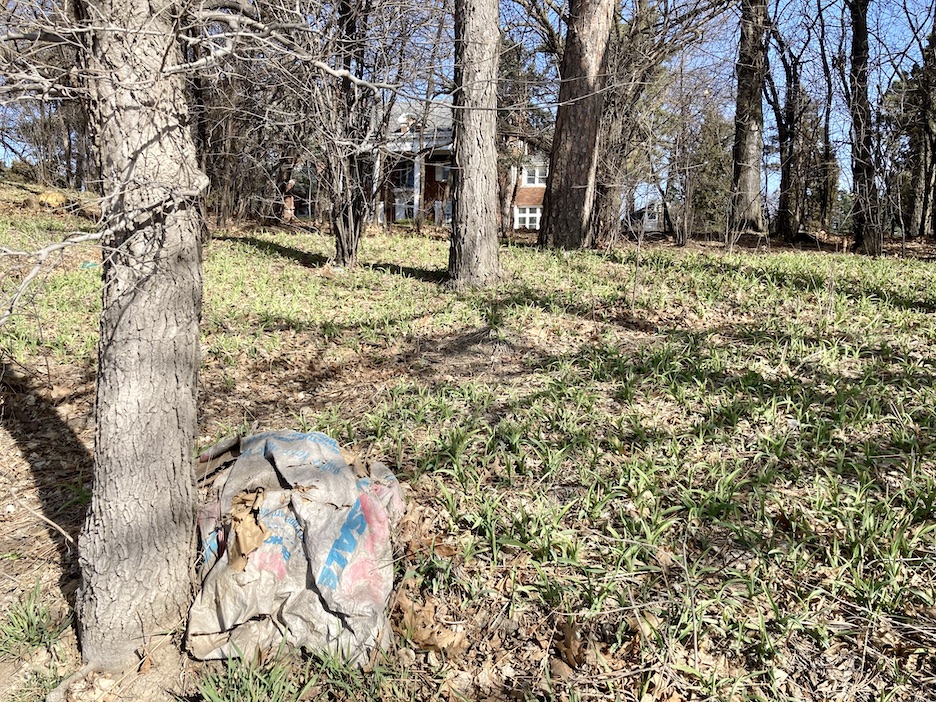
I rooted around and found the last of Dr. Quinn’s disintegrating Costco bags. RIP.

1938 at 6300 Dodge Street. Oh to see what once was! Bostwick and Frohardt, photographers. Durham Museum.
I welcome your feedback and comments on this beautiful Omaha landmark, dear 6300 Dodge. Let’s hear it for 6300 Dodge, old and new. Please share your additional clues to the story in the “Comments,” as we know more together. Everyone would love to read what you have to say and it makes the sharing of Omaha history more fun. You can use an anonymous smokescreen name if need be. We want to hear from you.
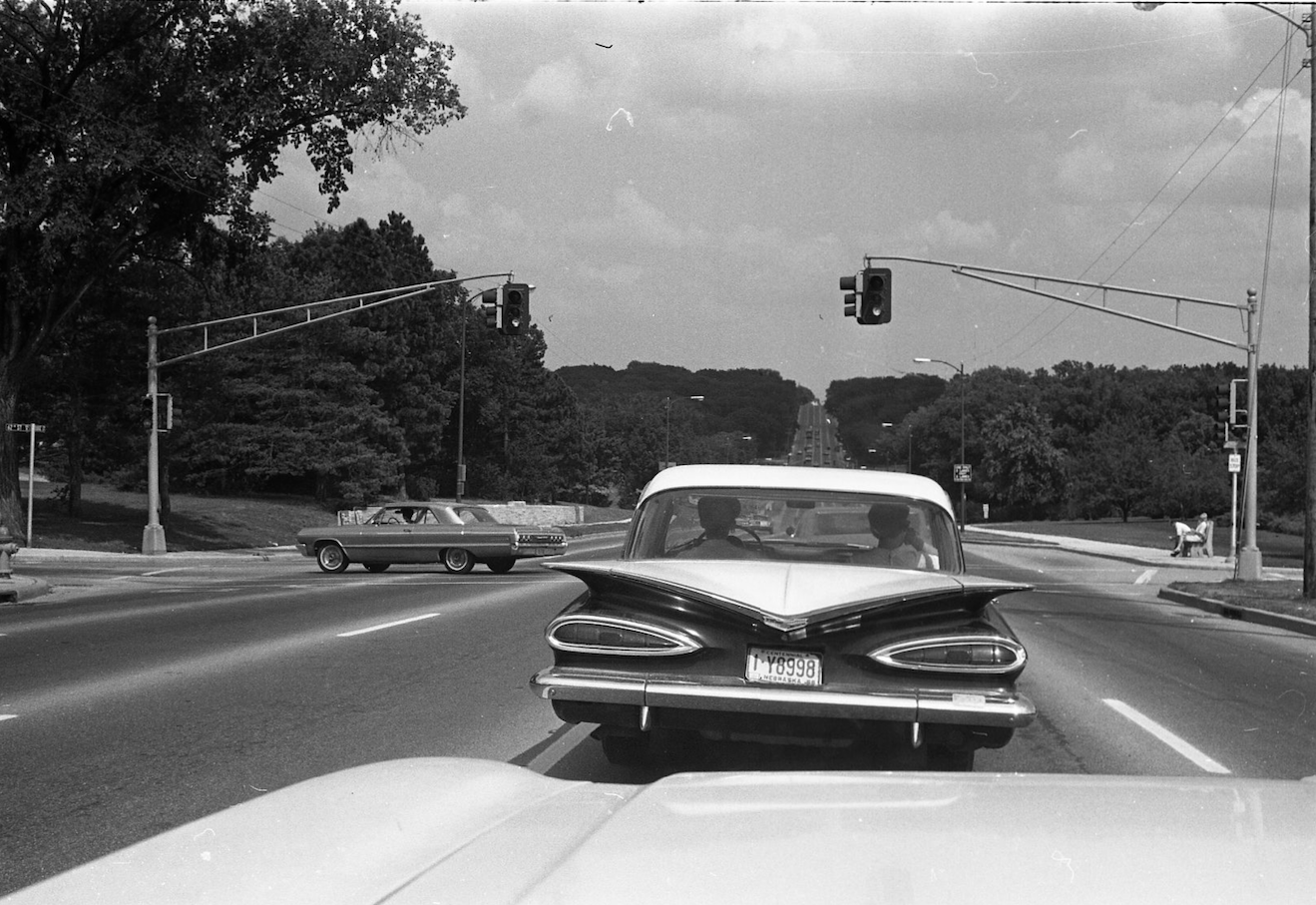
Two people in a 1959 Chevrolet Impala drive down Dodge Street. Photograph taken at 62nd and Dodge Street facing East. 1968. Paskach, Robert.
You can keep up with my latest investigations by joining my email group. Click on “Contact” then look for “Sign me up for the Newsletter!” Enter your email address. You will get sent email updates every time I have written a new article. Also feel free to join My Omaha Obsession on Facebook. Thank you, Omaha friends. Miss Cassette
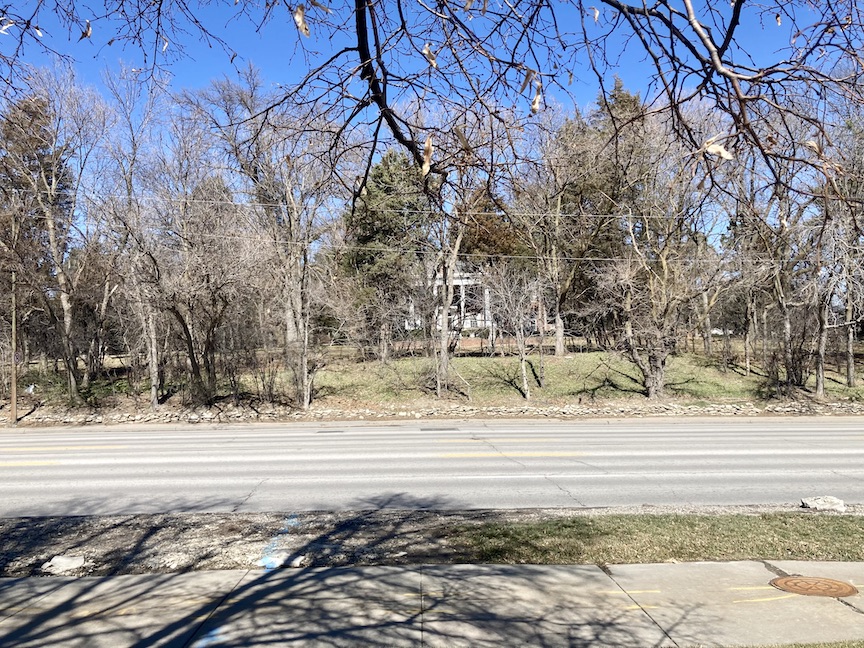
© Miss Cassette and myomahaobsession, 2024. Unauthorized use and/or duplication of this material without express and written permission from this site’s author and/or owner is strictly prohibited. Excerpts and links may be used, provided that full and clear credit is given to Miss Cassette and myomahaobsession with appropriate and specific direction to the original content.

If you are looking for more architectural and Omaha history sleuthing fun, ask your local or bigbox bookseller for my book: My Omaha Obsession: Searching for the City. Also available everywhere online. Thank you.
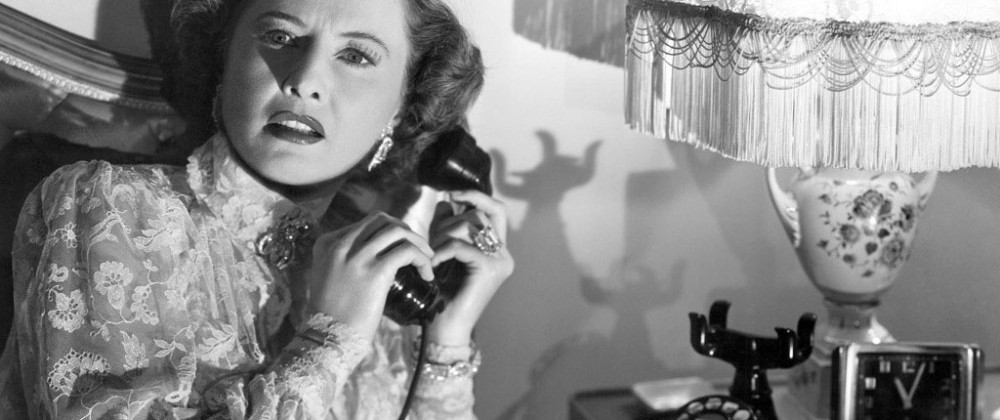
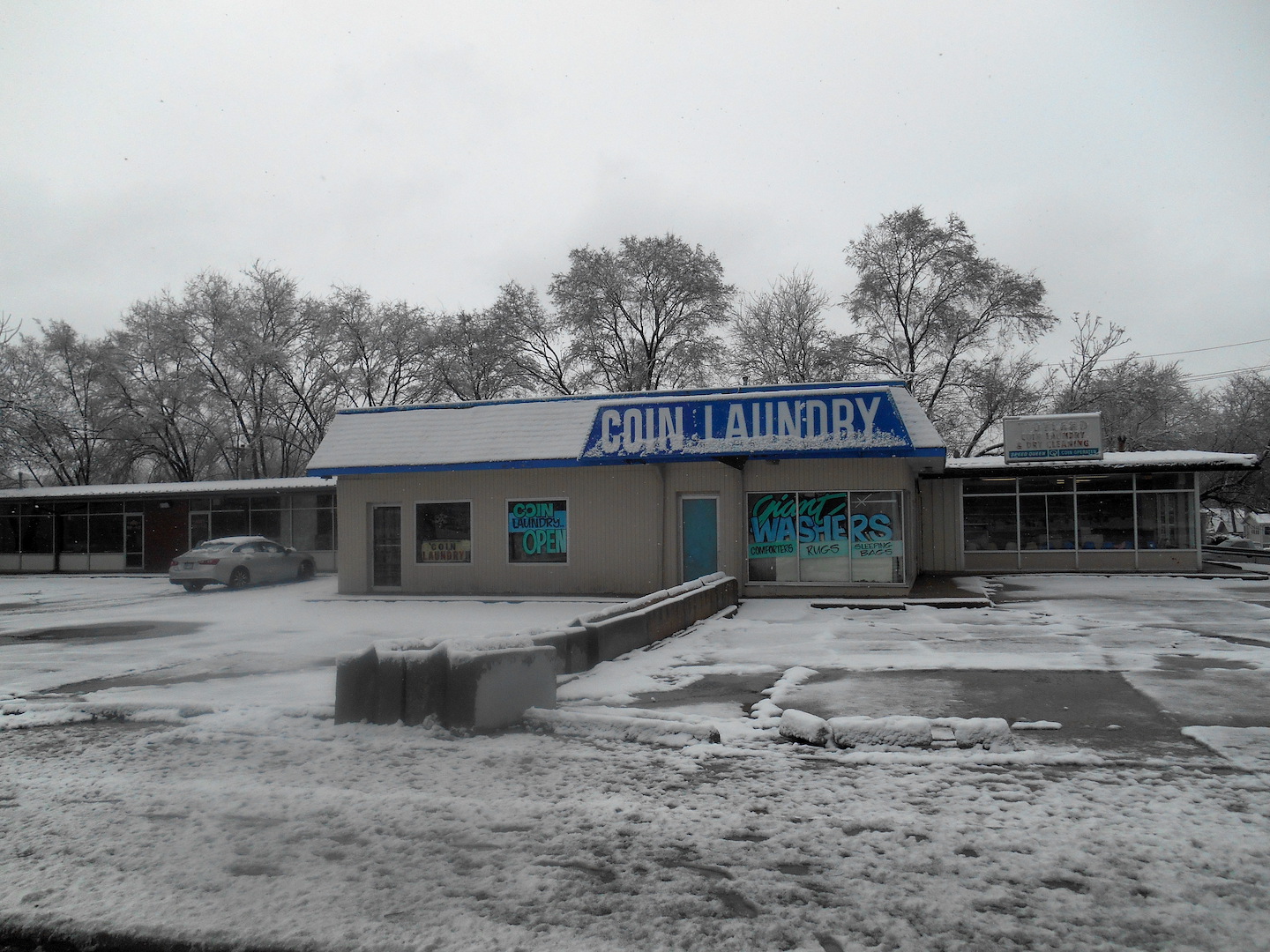
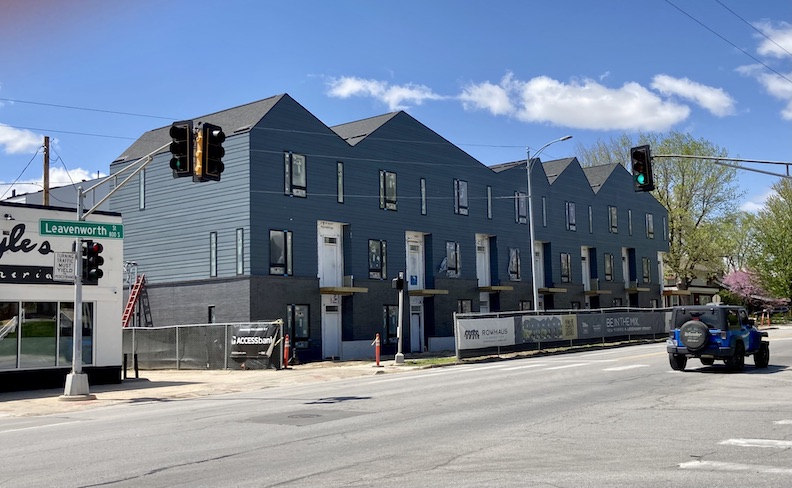
One of my favorites of your investigations!! ????
Hoping for the best.
Thank you, Andrea! It will be interesting to see what happens. I hope she makes it through!
You’ve answered questions about this landmark that I’ve had for years! Incredible job, Miss Cassette!
That means a lot, Kevin. Thank you!
Omaha needs affordable housing, regardless of the cookie cutter/plain-label architecture dislike some have, and that plot of land has more potential than the current architecture can be given bonus points for. .
However, will the proposed homes/buildings be “affordable” that seems highly unlikely. And if they were affordable the neighbors might have issues claiming a detriment to their property values (although this claim has been disproven over and over) and safety issues (also widely disproven).
Perhaps razing the past isn’t a detriment to raise up the future of our city.
Appreciate the hard work that goes into writing and researching these articles, truly.
I appreciate your thoughtful words. Affordable housing is exactly what is missing from the Omaha and national equation. there are many reasons why developers aren’t interested in those kind of projects right now. And the perception of affordable will be changed in time as regular working folks’ options will become more and more limited, as owning property will be removed from the equation. My interpretation of this particular parcel of land, (if sold, razed and developed,) is that they will only be able to sell it to the neighborhood if they make it into townhomes or condos. These will be expensive places or touted as luxury housing. Thanks again for the thoughtful exchange.
You can’t raise the future of the city by making a habit of destroying its past. When the mindset and practice for the last fifty years have been the wholesale demolition of Omaha’s landmarks and huge swaths of its urban landscape, living history dies and context and sense of place no longer exist.
I don’t see any arguments here or anywhere against responsible and “affordable” housing.
What I do see is the fallacy that, somehow, we can only have one for the other. There’s no reason to sacrifice history for housing, just as theres no reason to sacrifice housing for history. Omaha isn’t landlocked. There’s room for both. The real problem is the absence of creativity, foresight, and visionary leadership at every level.
Sadly, this was revisiting old heartaches. I’m a friend of Greg Jahn’s since childhood and was a member of Landmarks during this time. The failure of that project along with the Gene Leahy Mall and Jobber’s Canyon debacles was what finally drove me away from Omaha. The destruction of history for transitory change under the guise of progress was too much to bear. Witness the large and gorgeous WOW building destroyed and replaced with a little “modern” squat structure. And the mall and Conagra campus = empty vessels. You can’t bring back buildings like the Philadelphia Leather Building and so many others that have been destroyed. Same holds true for the West Farnam mansions that gave way to Mutual of Omaha, etc. So much history is forever lost. Sad part is, most people don’t want the modern”crap”. They want the look and feel derived from areas like the Old Market. OK, time to get off my soap box. Thank you so much for the absolute in depth research. Eight years and yet there is so much more of Omaha still to cover.
The Barton mansion on Farnam not too far from the Storz mansion was razed for Security National Bank back when.
I agree with your sentiments. Too much historical architecture has fallen for the sake of progress. Old post office for the hotel and bank downtown, city hall replaced by Woodmen Tower, the list goes on and on.
The Old Market would have disappeared a long time ago had it not been for the Mercer family and their foresight.
I love the mixed architectures of the old and new in downtown Chicago. Something we will never see here.
The Barton Mansion was a real sleazy ordeal. It was on the National Register of Historic Places to supposedly protect it. Unfortunately, only the exterior was registered. First step was to totally “gut” the interior to insure that it couldn’t be used and was only an empty shell. Second step was to have the demolition machinery moved into place at 2:00 AM on a Sunday morning with demolition to begin as soon as there was light. This would prevent any protests or stop any legal injunctions until it was too late to do so. (I lived on 36th Street and was awake at the time the machinery was moved – I just didn’t realize what it was for until later,) By the time people noticed what was happening, it was almost completely demolished. Security had to pay a small fine (I believe it was $50) for demolishing without a permit. The Bank president was seen holding the tower top weather vane up as a trophy. I think I need to stop here before I say something not so nice 🙂 Few people realize that the Barton Mansion had air conditioning from the 1890’s – I think it was ammonia based and circulated through the radiators. The carriage house horse stalls were marble and mahogany.
When 6300 was listed, it appeared rather creepy looking at the pictures.
As an aside, Ralph Blank and his family lived in a large home in Fairacres.
He was the owner of the Skyview Drive In, Admiral and Chief theaters.
Well done Miss Cassette! This post is remarkably researched and fascinating. I remember this grand home when it was the 1984 Designer’s Showhouse. And I see remnants of this period in a few of the real estate listing photos. Its glory days are gone. And based on your research, it’s been foreshadowed decades ago.
I may be an outlier in my opinion, but I sadly think 6300 Dodge needs to be razed. While the house is beautiful, it’s suffered years of deferred maintenance. And to find a single family willing to take on the renovation expenses and maintain it to the level of the neighboring homes is mired in antebellum thinking. It’s not practical or realistic for modern living. And I’d hate to see a business or government entity take it over. More deferred maintenance.
Ideally, it becomes subdivided into a few smaller lots with homes built that reflect the history and heritage of the neighboring estates. No McMansions. These new homes should be, as the architectural firm McAlpine House calls them, “inheritable homes”. Classic styles that won’t feel dated in ten, twenty, or even one hundred years from now.
We will collectively wring our hands and hope for the best—either a dedicated and patron sponsor of a renovation; or thoughtful and considered new builds. Life marches forward and we will celebrate 6300s history and possibly bid her adieu….
I heard today that “developers” plan to demolish the parking garage over 17th Street connected to the Brandeis building. Of course, removing that garage is good thing and long overdue. However, there’s a sound rumor that they’ll take down the Brandeis building with it, under the guise of OOPS!
You can’t raise the future of the city by making a habit of destroying its past. When the mindset and practice for the last fifty years have been the wholesale demolition of Omaha’s landmarks and huge swaths of its urban landscape, living history dies and context and sense of place no longer exist.
I don’t see any arguments here or anywhere against responsible and “affordable” housing.
What I do see is the fallacy that, somehow, we can only have one for the other. There’s no reason to sacrifice history for housing just as theres no reason to sacrifice housing for history. Omaha isn’t landlocked. There’s room for both. The real problem is the absence of creativity, foresight, and visionary leadership…at every level.
I just want to thank you for covering and telling the stories of Omaha family heritage homes. I remember our family trying to move our Farber home to join 6300 Dodge when Grandma Miriam died and learned UNO was going to demolish it, obviously that didn’t work.
So enjoy reading your stories and thank you for sharing!! NAC
PS – I also recently learned the Farber family former insurance company building, Service Life, 1905 Farnam, is being converted to apartments. N
I am not sure if this is going to Miss Cassette. I wanted to share that my mom (98 year old) worked at Harkerts. She would be great for Miss Cassette to talk to. I love talking to her about that time in her life. It was such a happy time for her. Text me at 6266649131 if you are interested.
Hi! I wrote you an email.
I love your stories about the history of Omaha. K
Thank you so much, Don! Are you perchance related to the Vendittes that I just wrote about in Little Italy? I hope so!